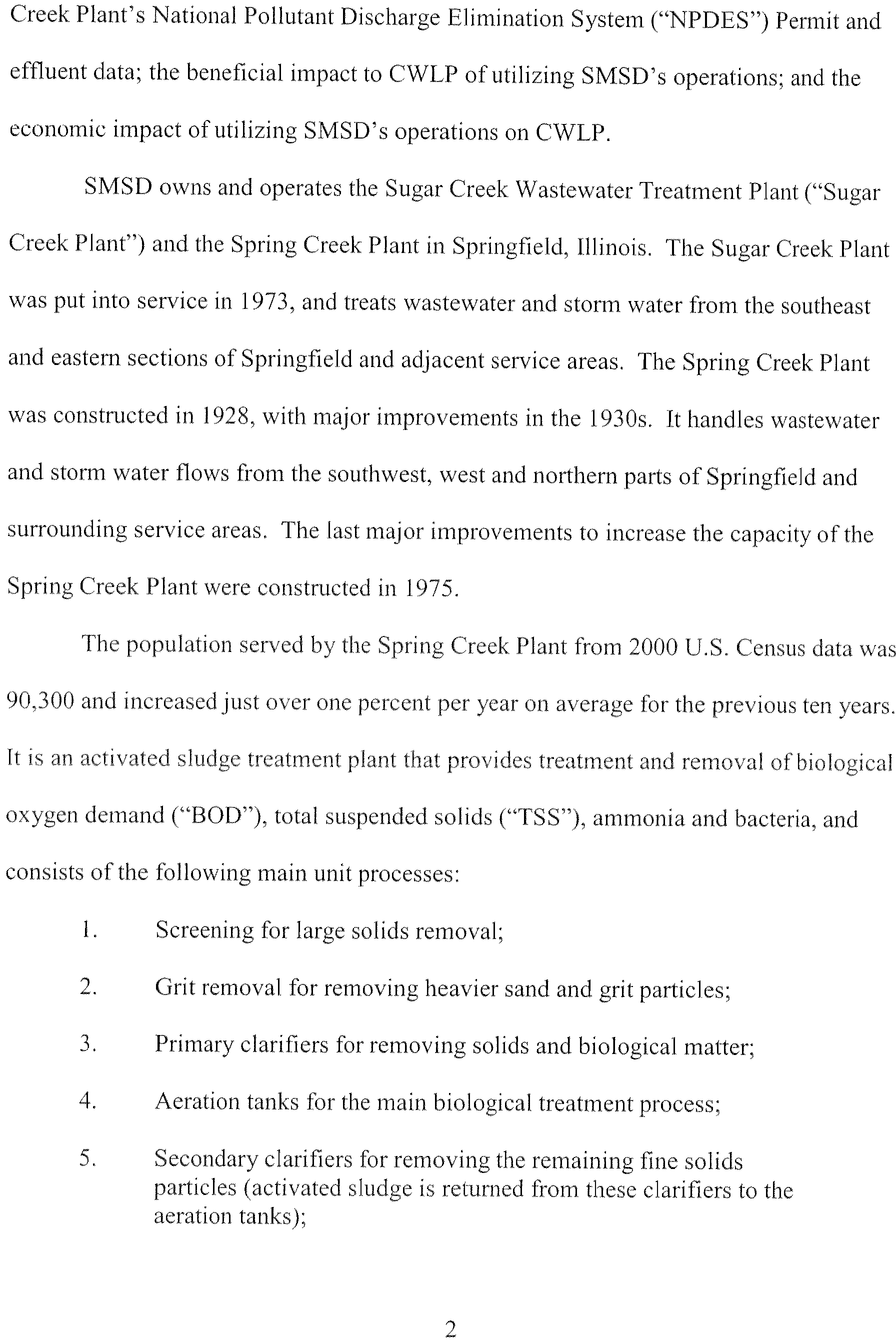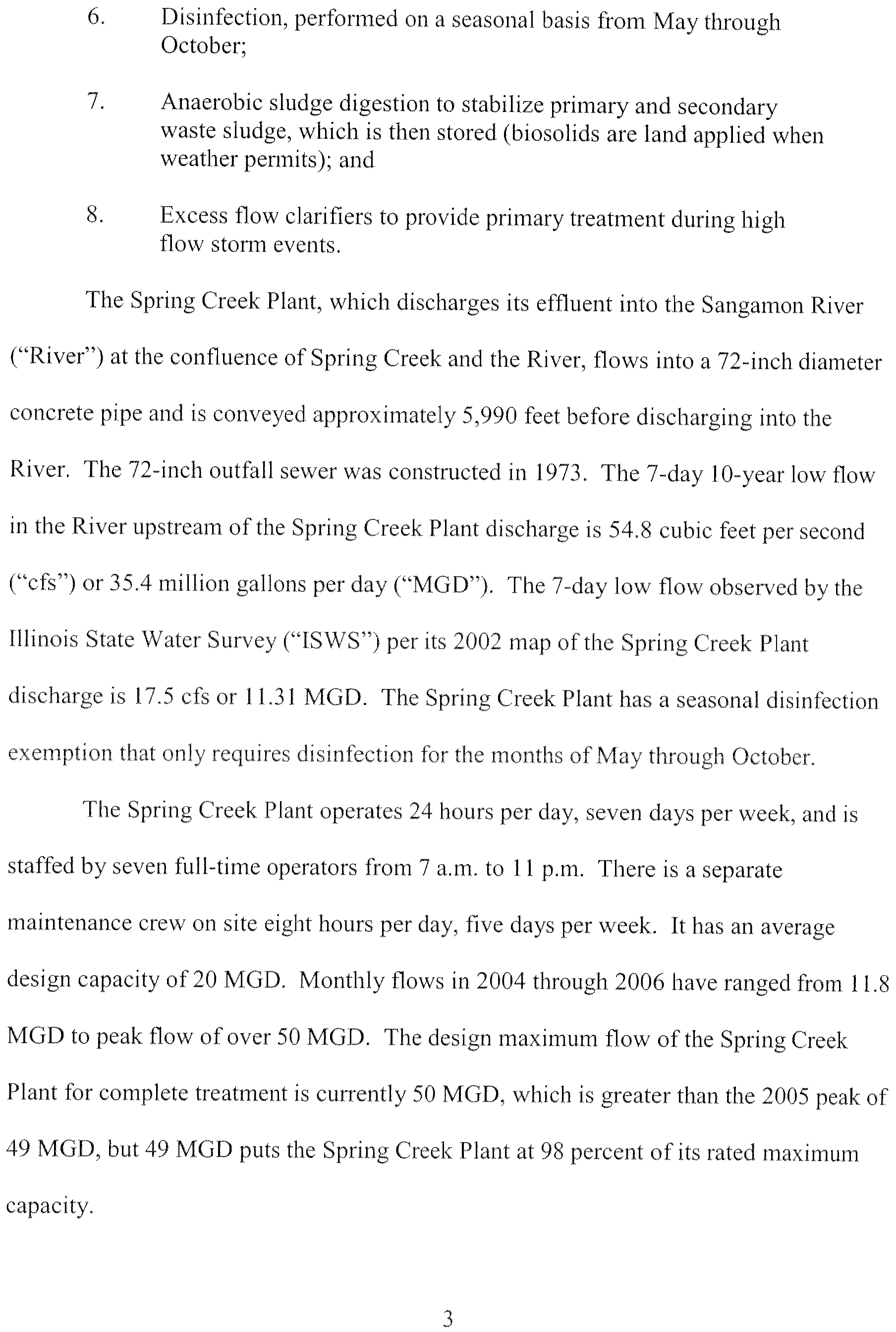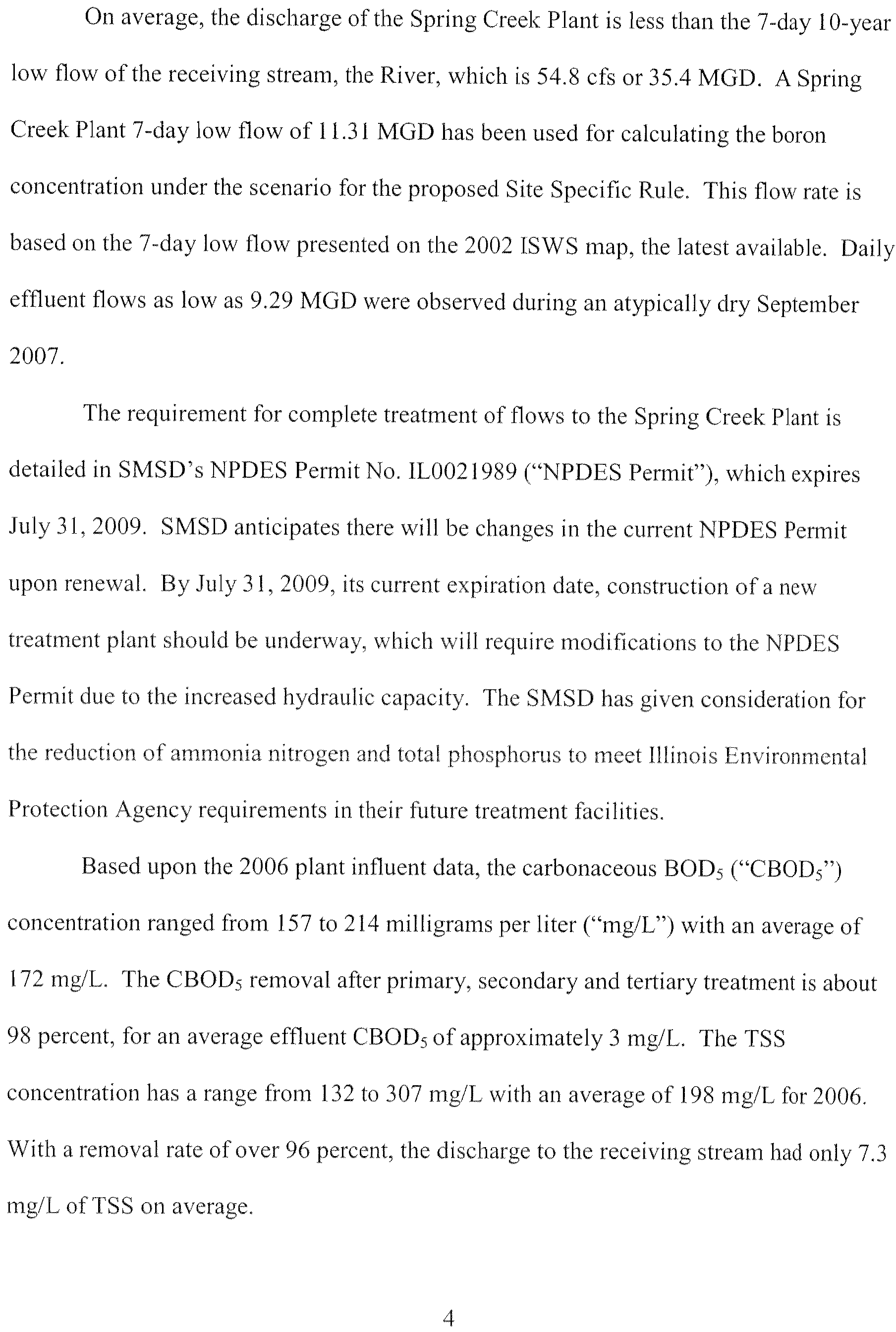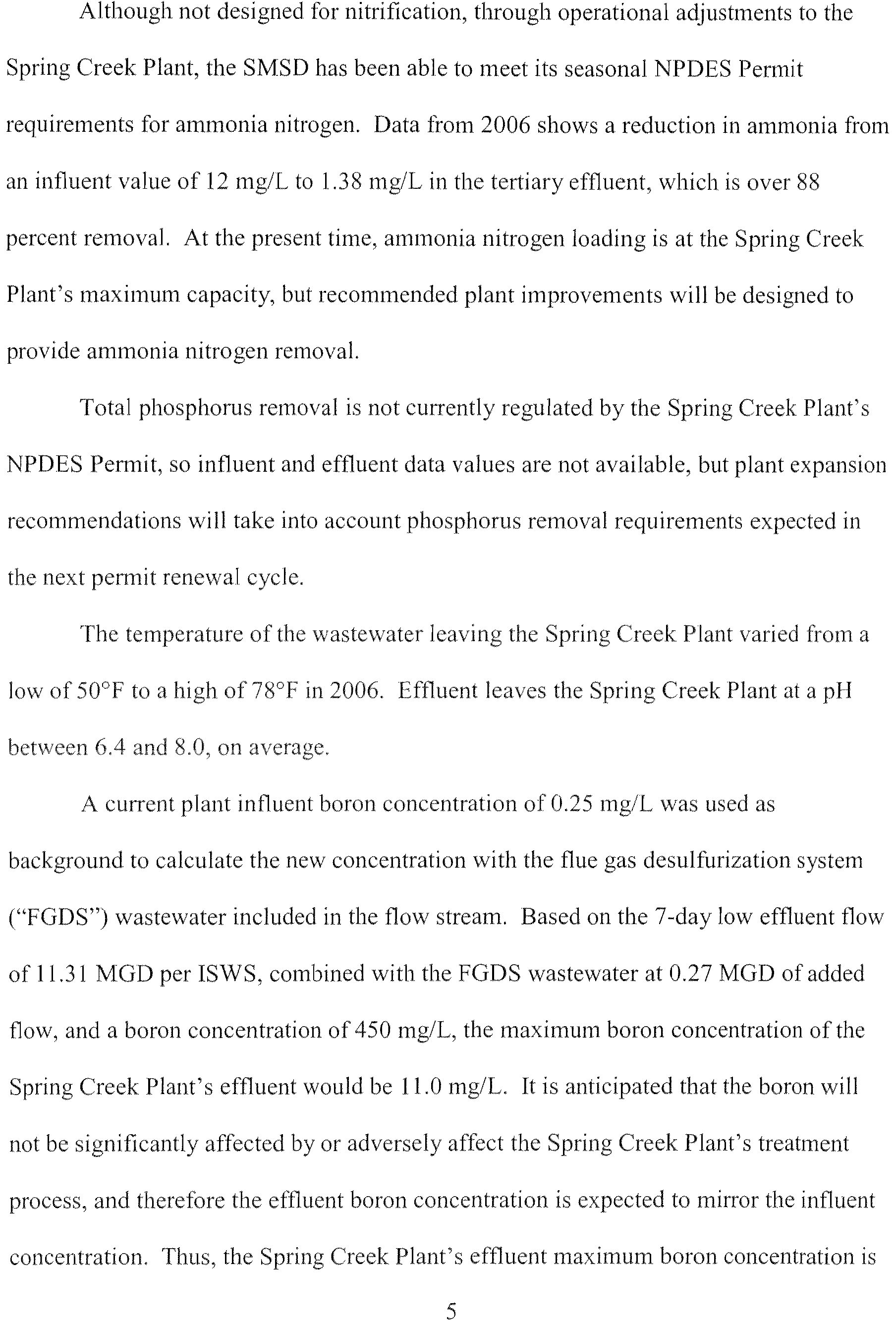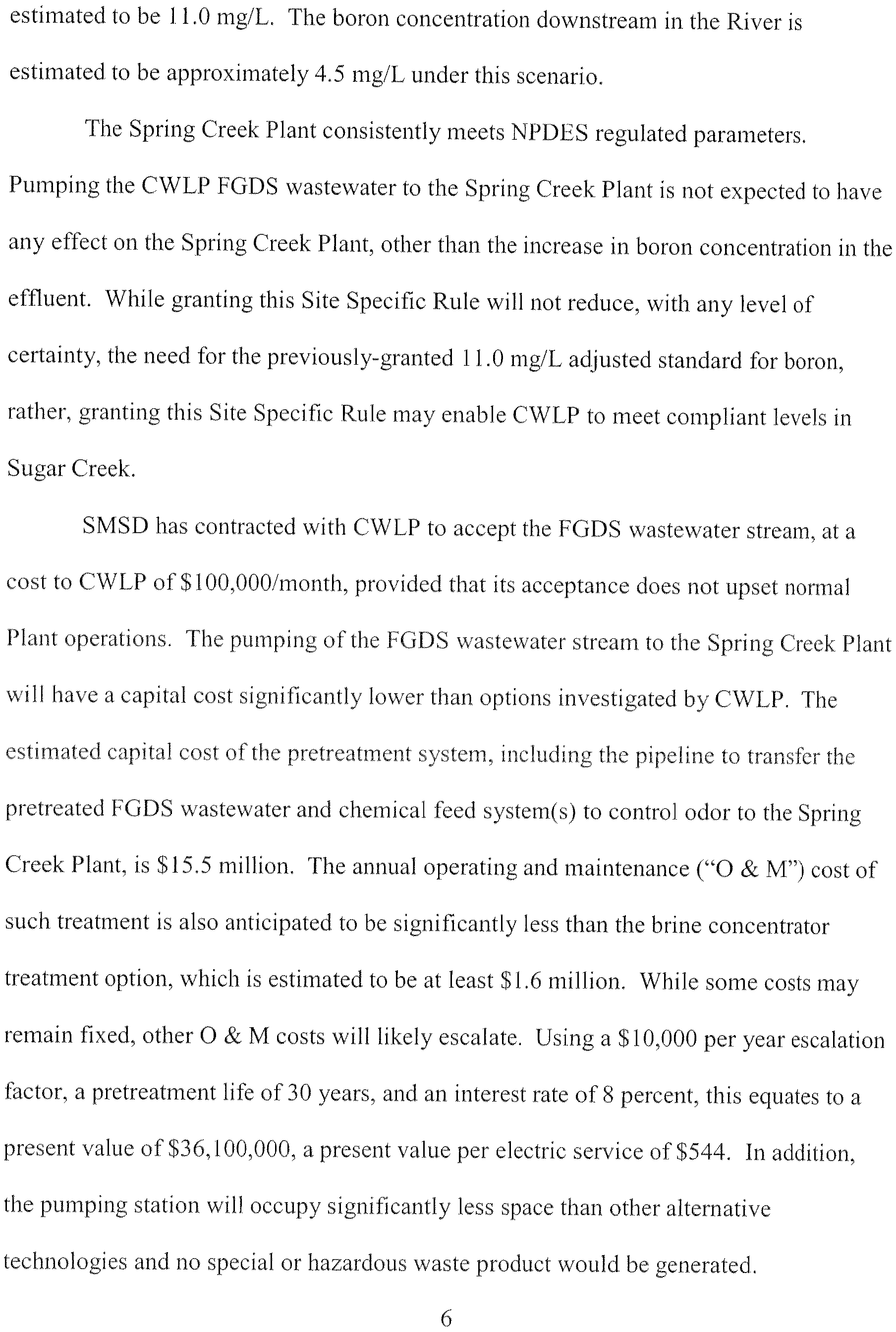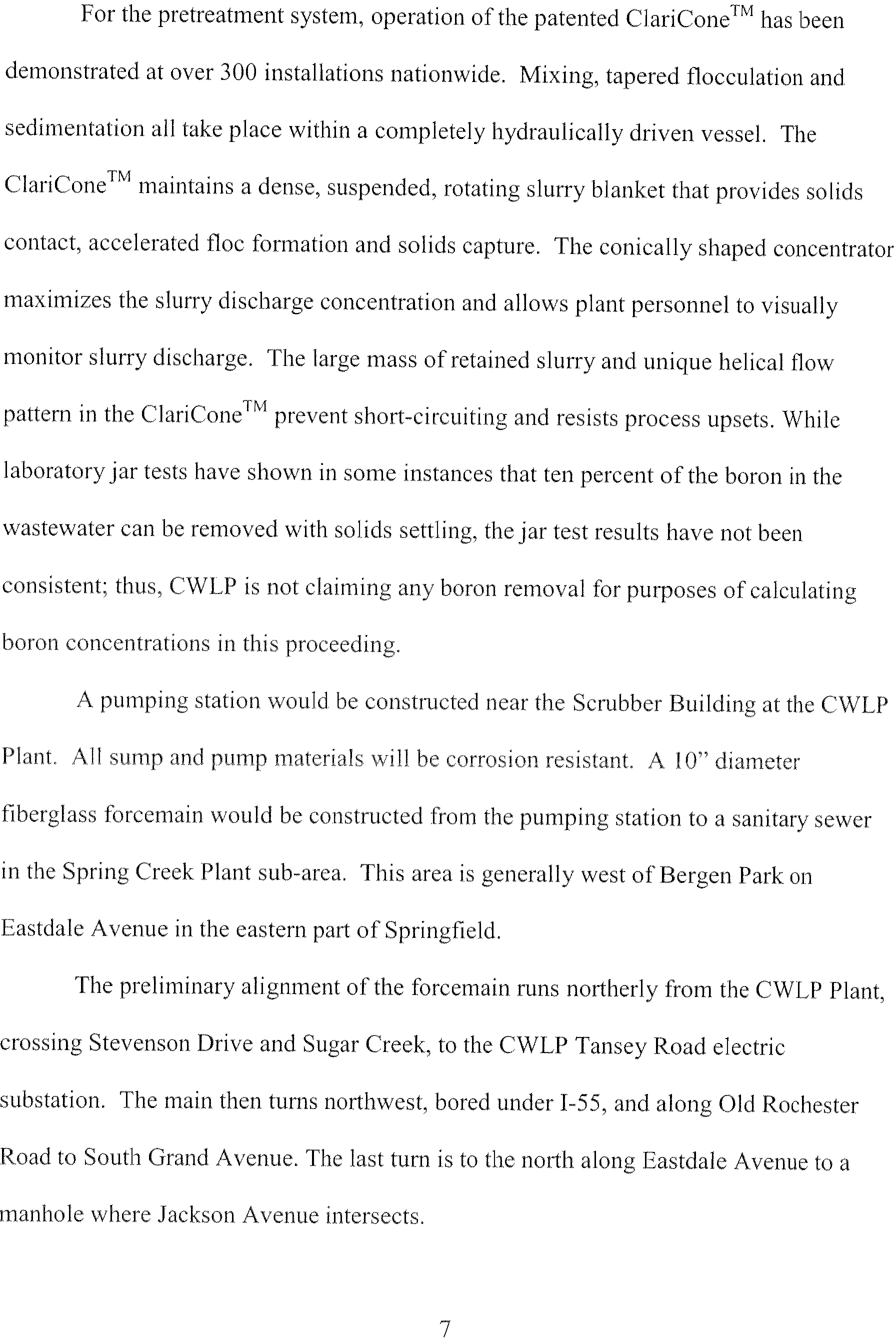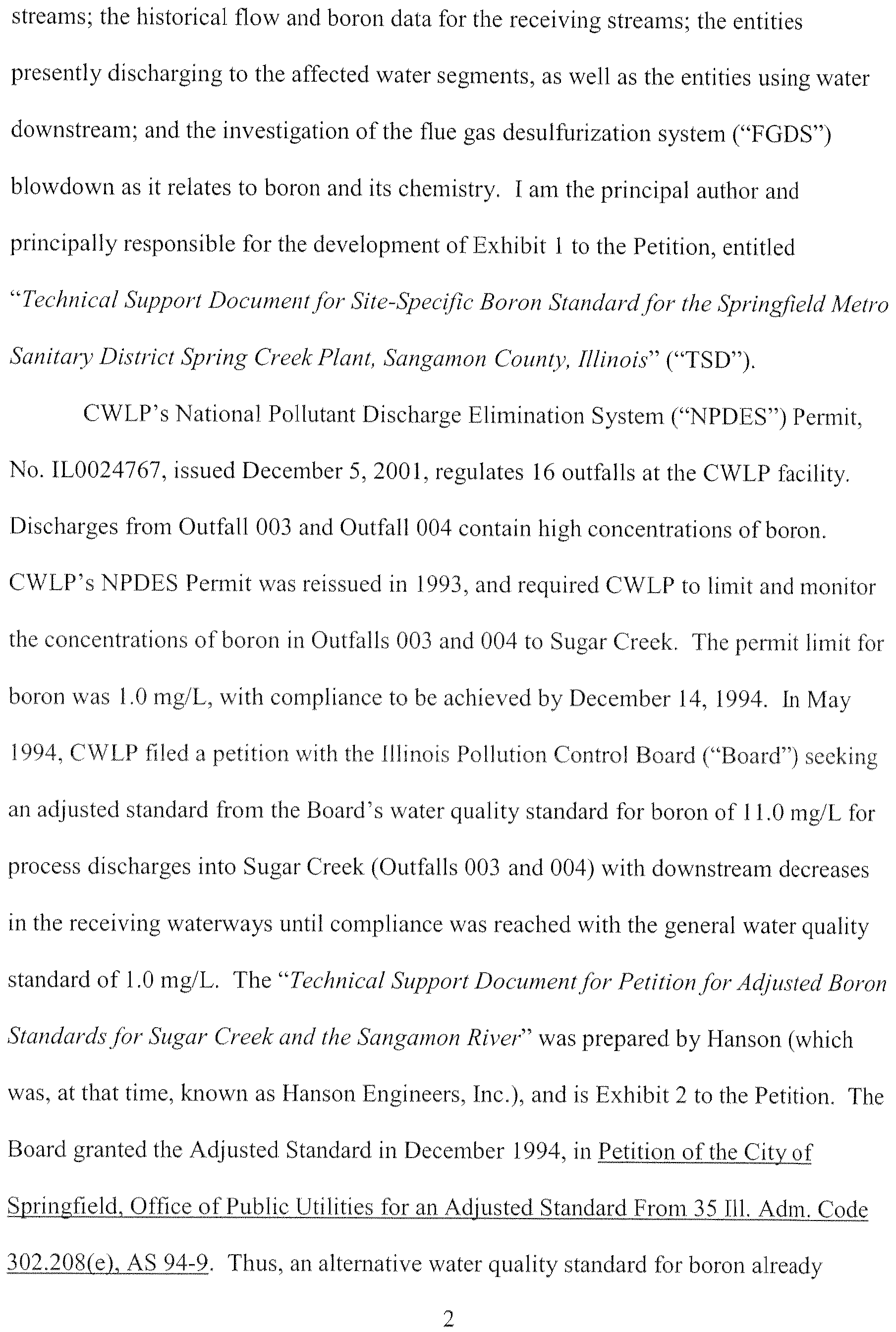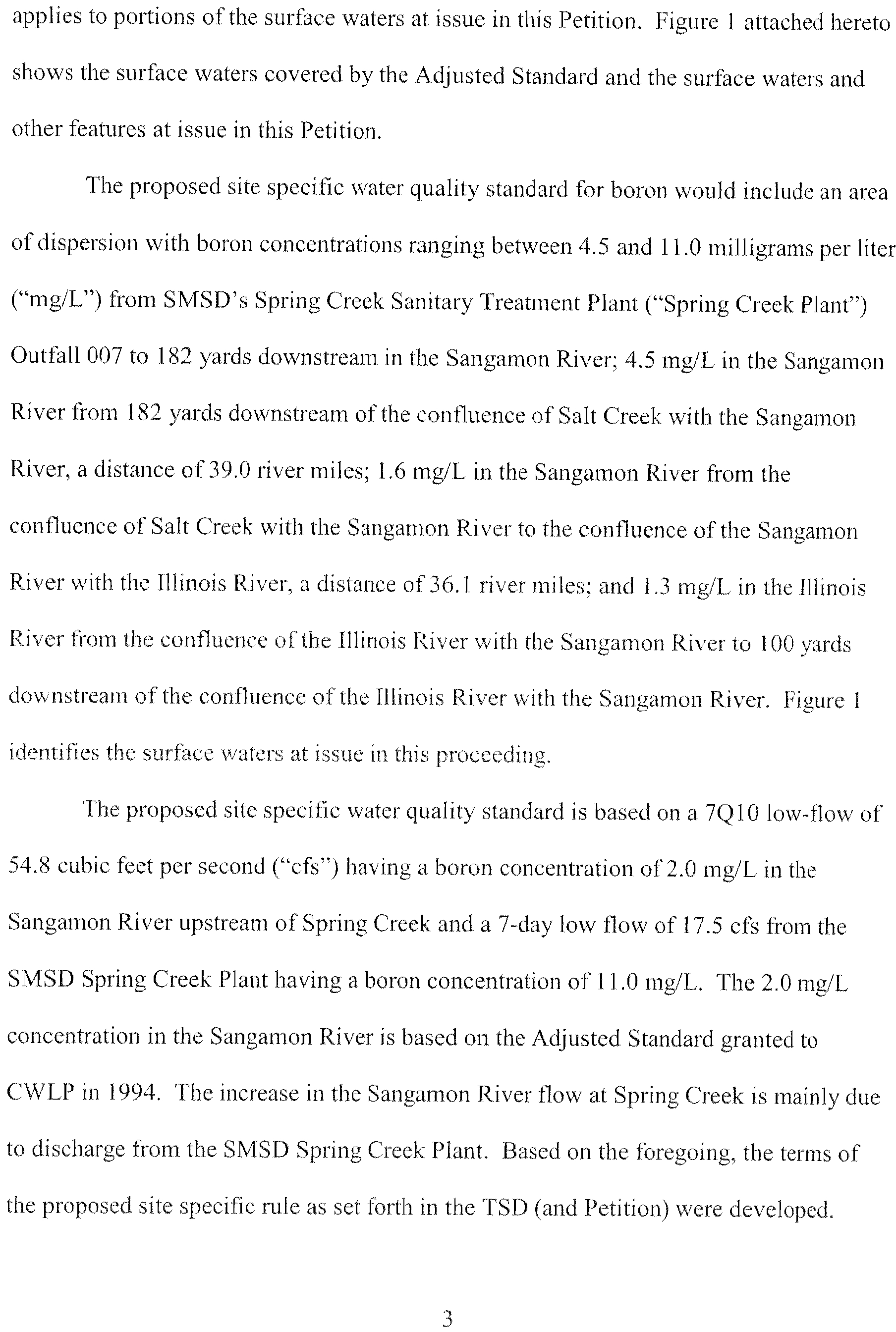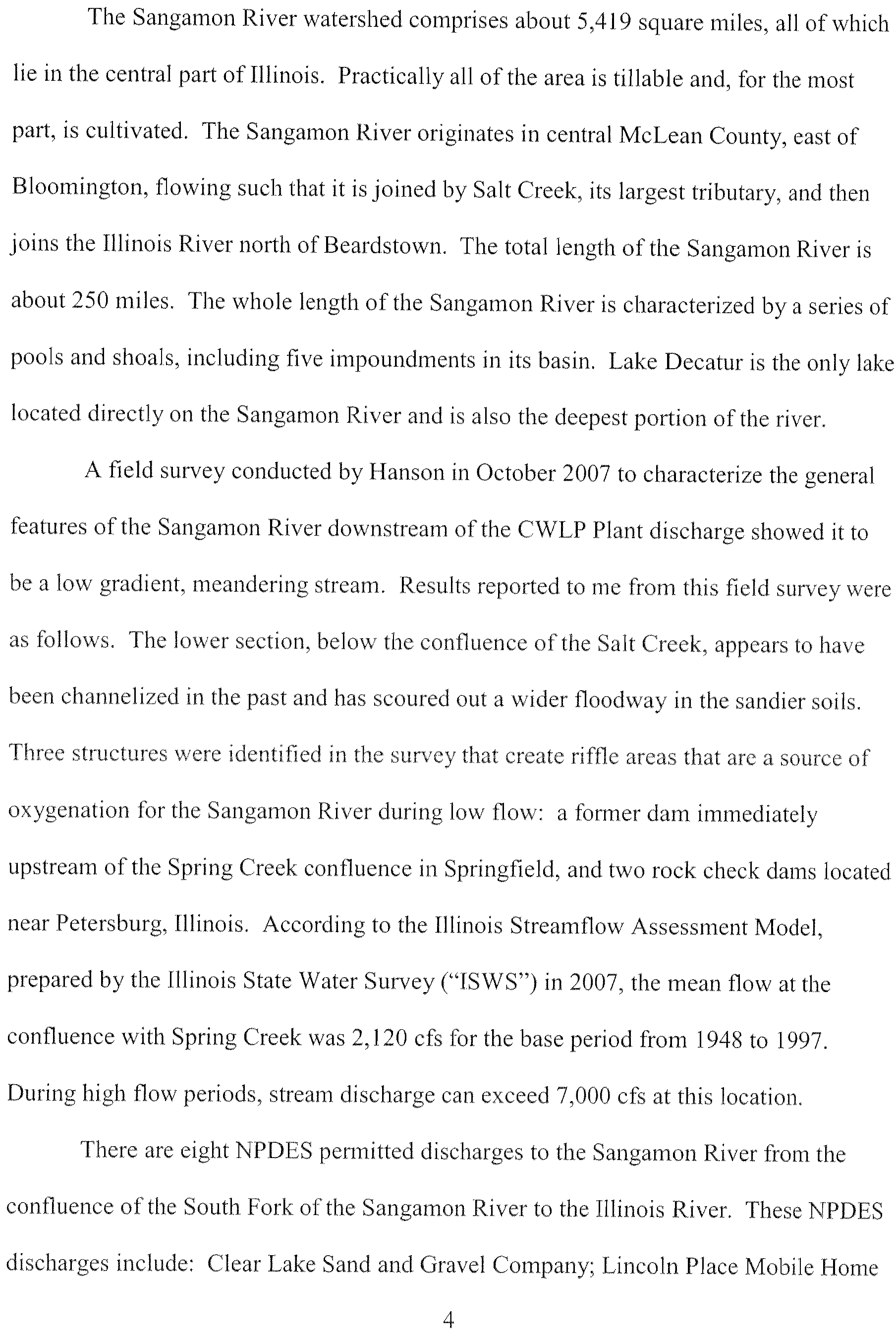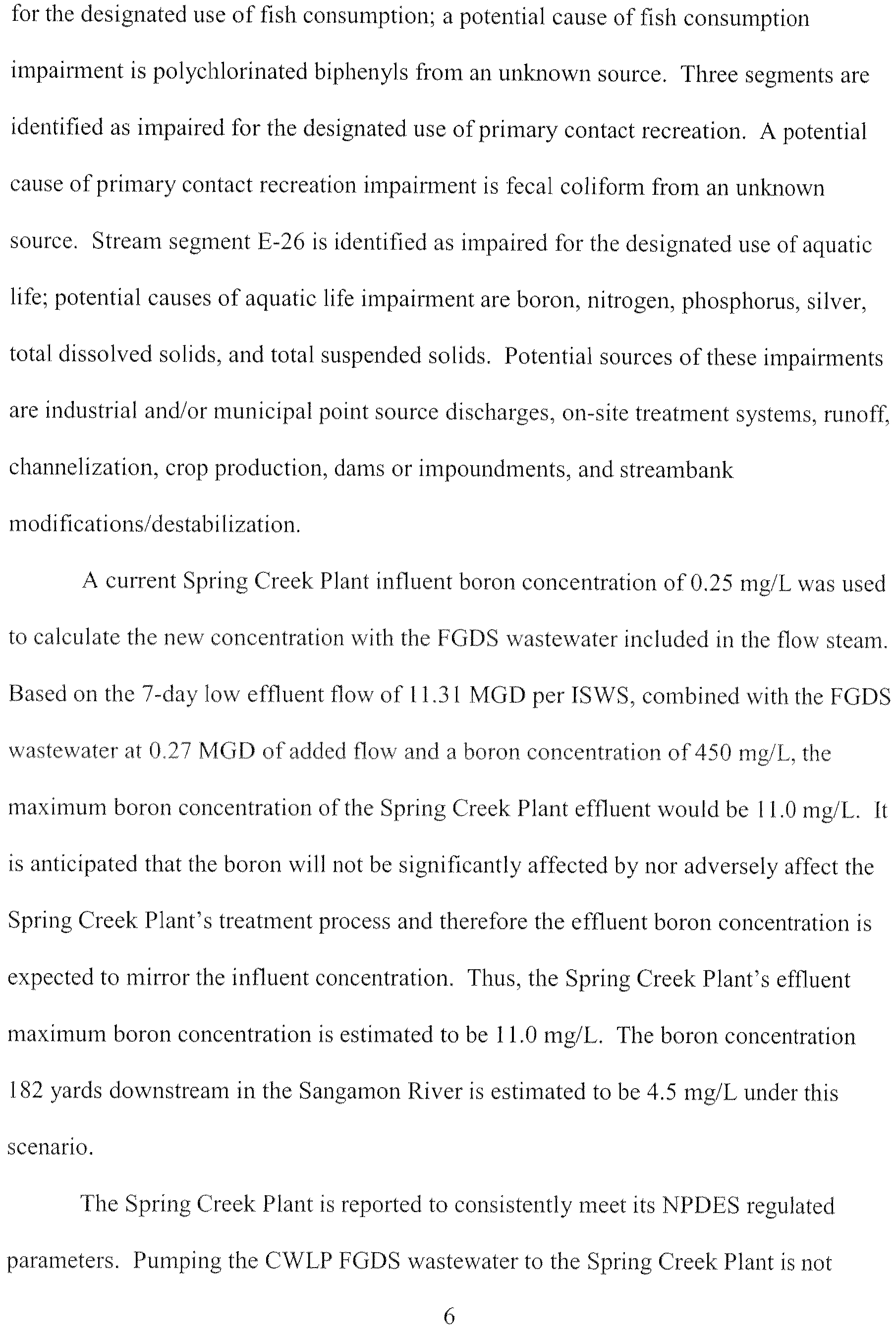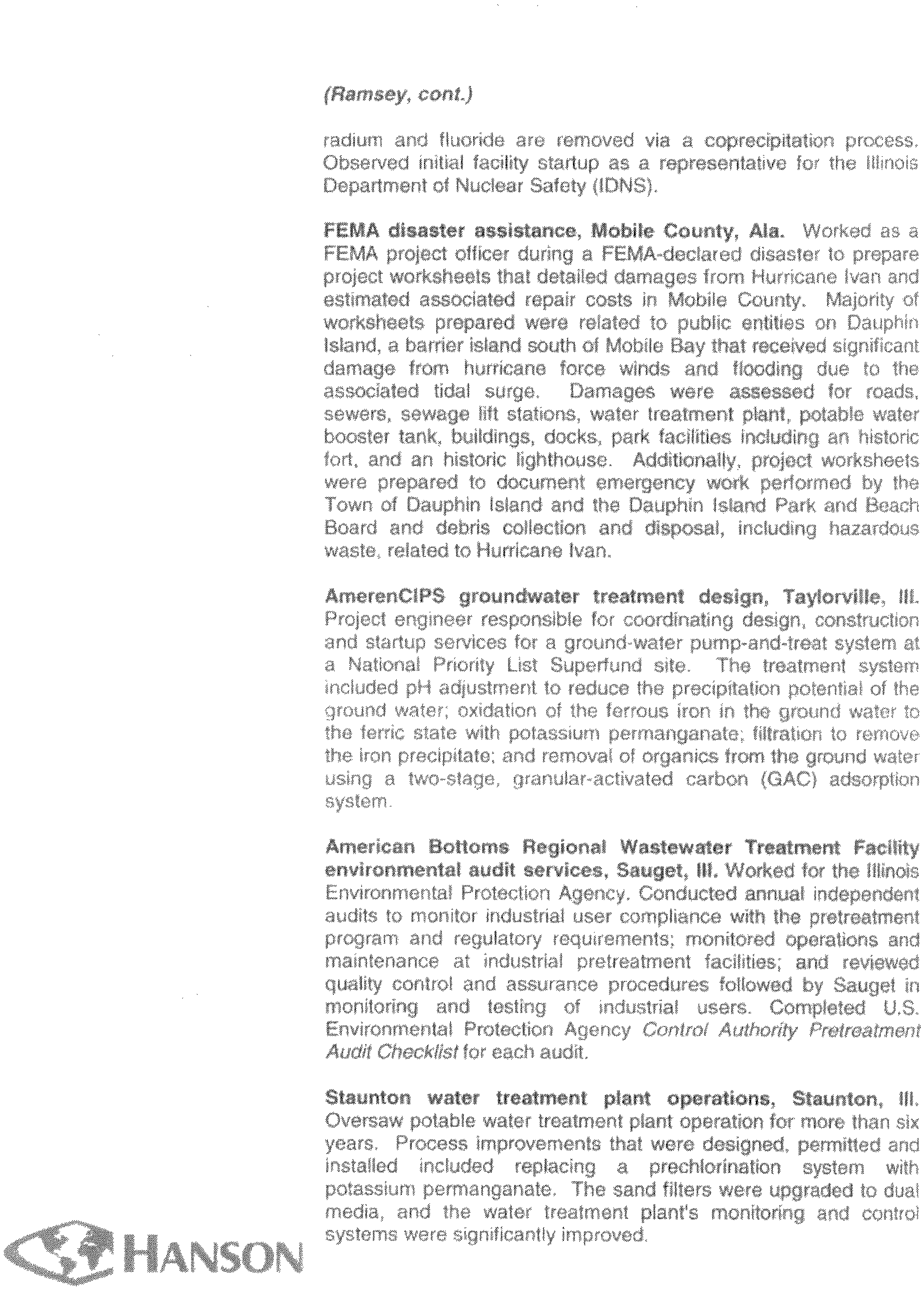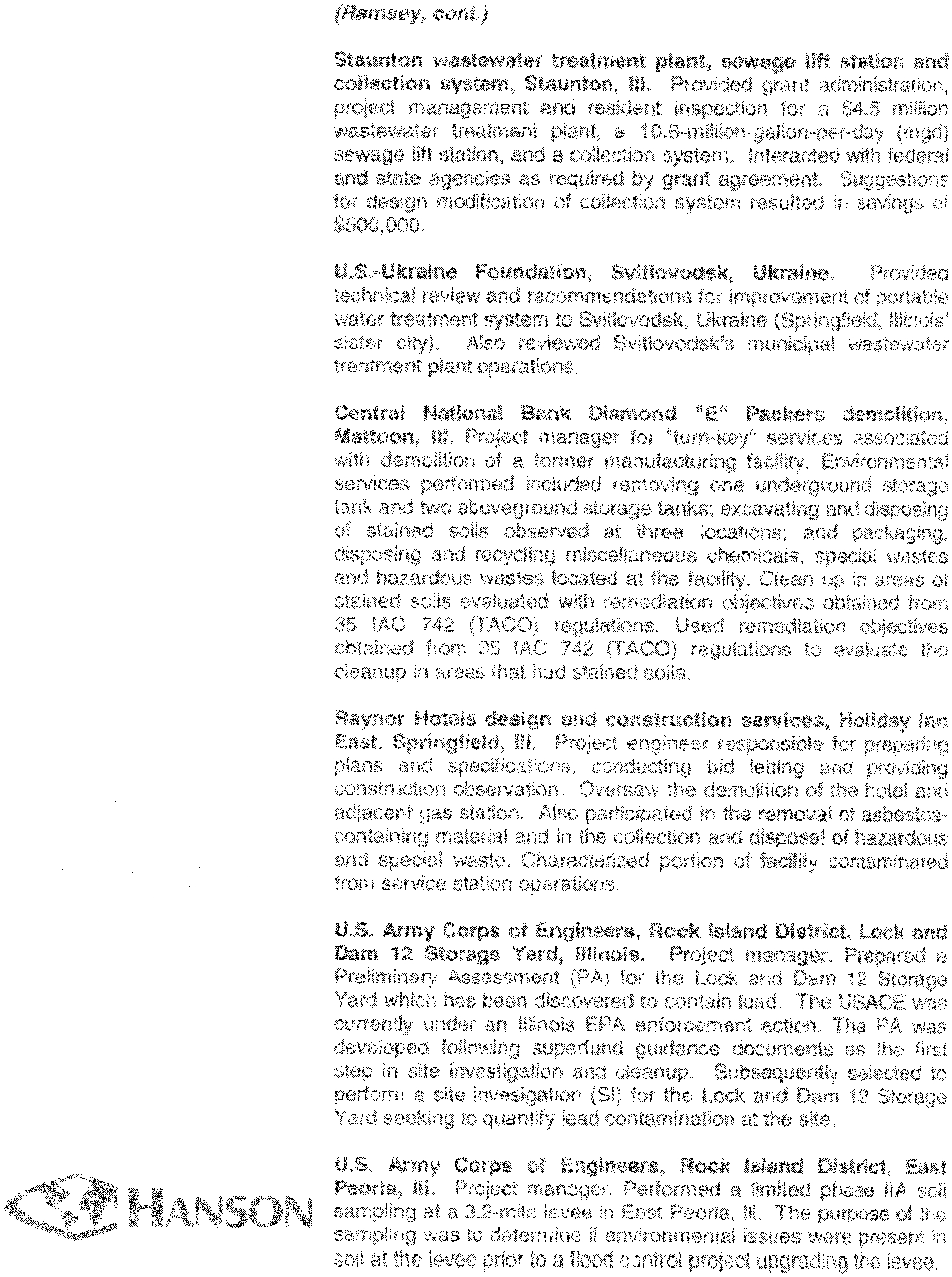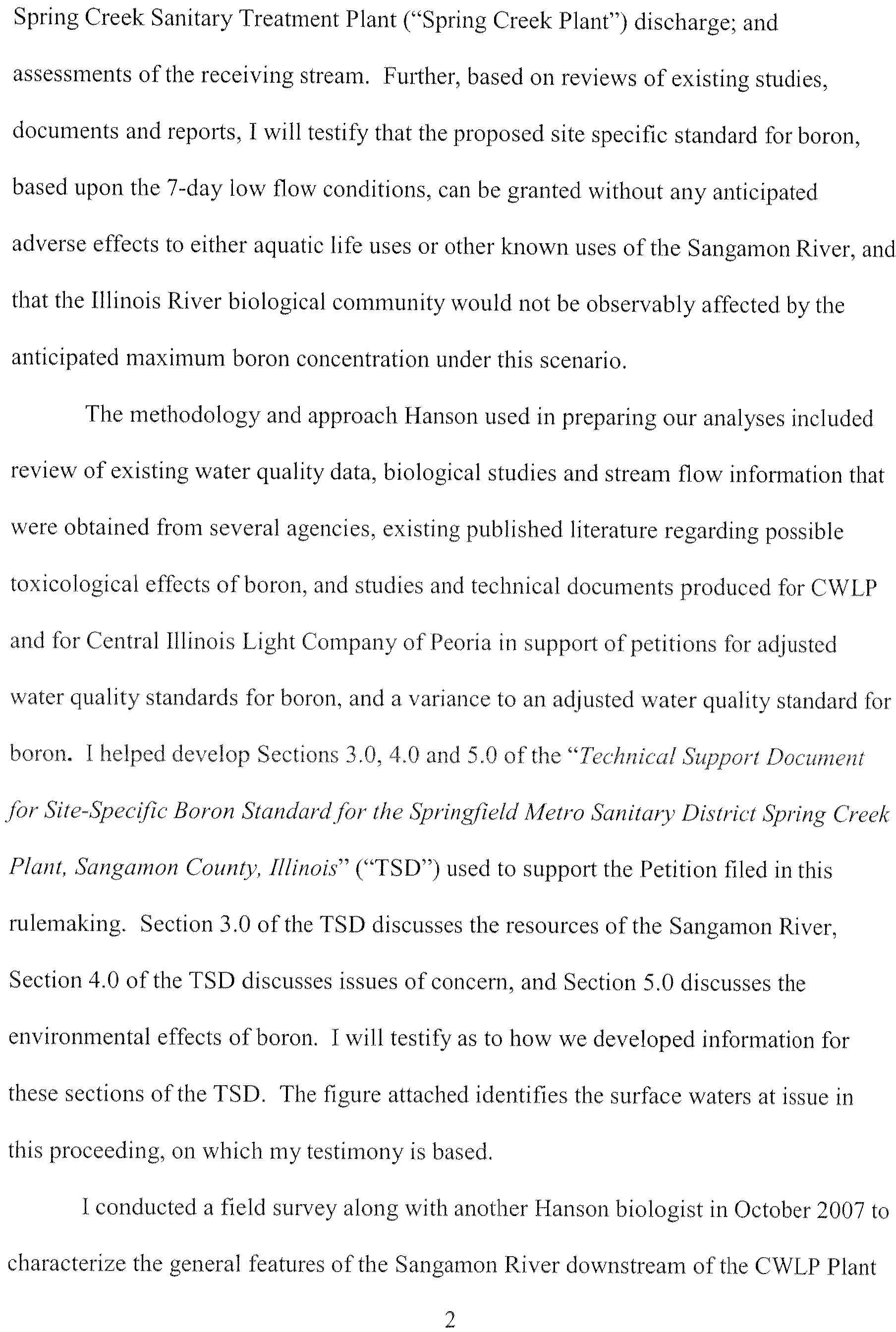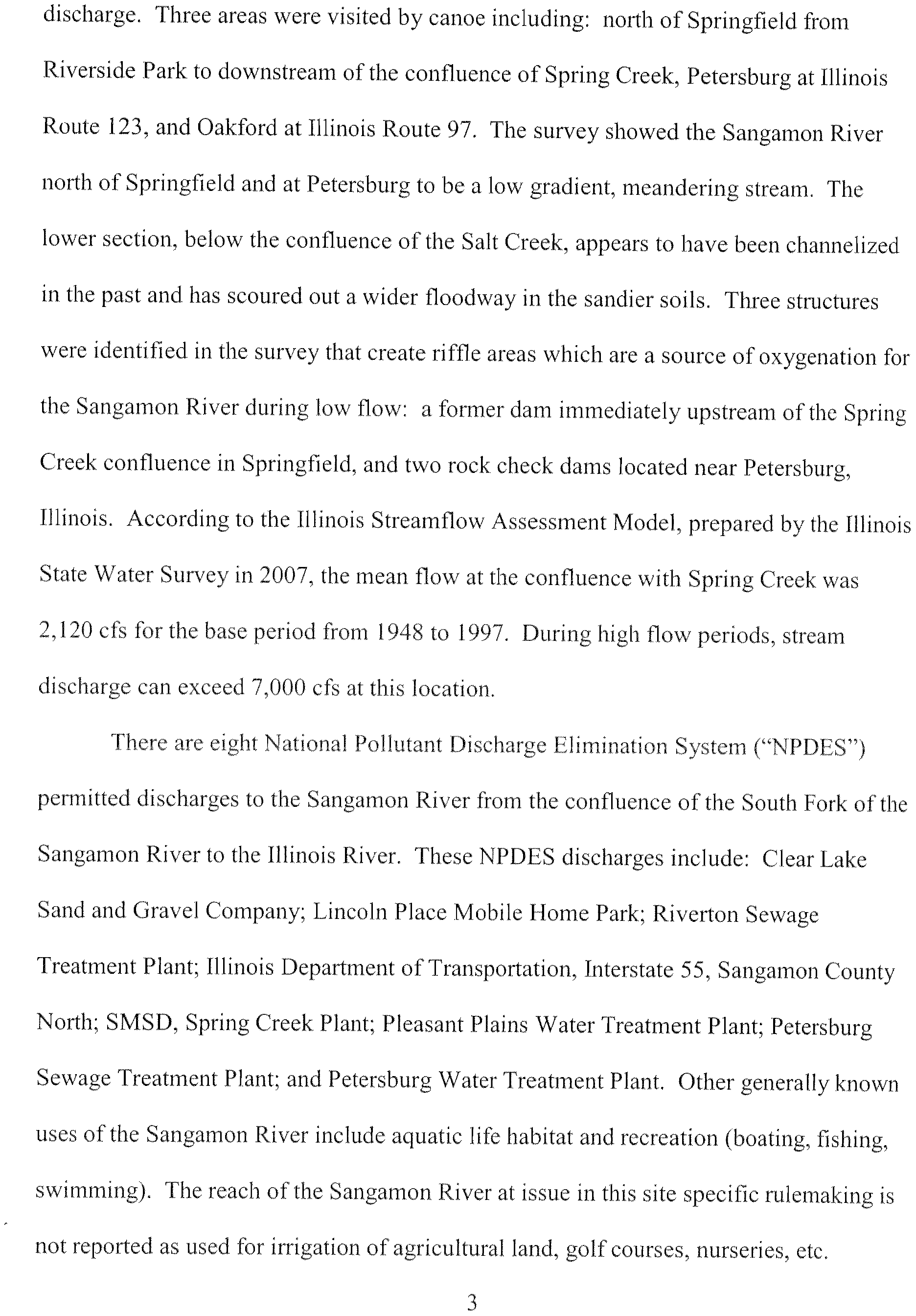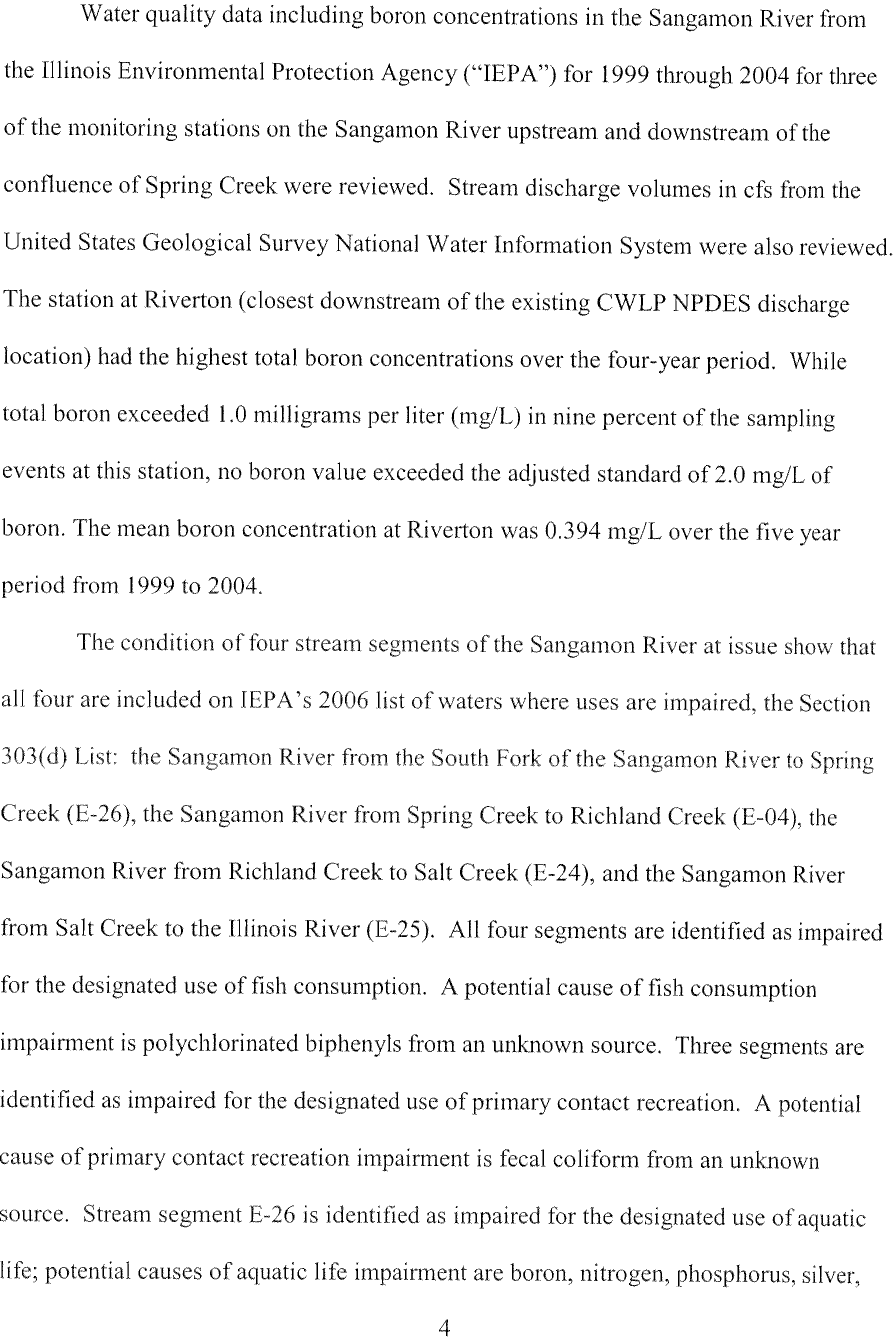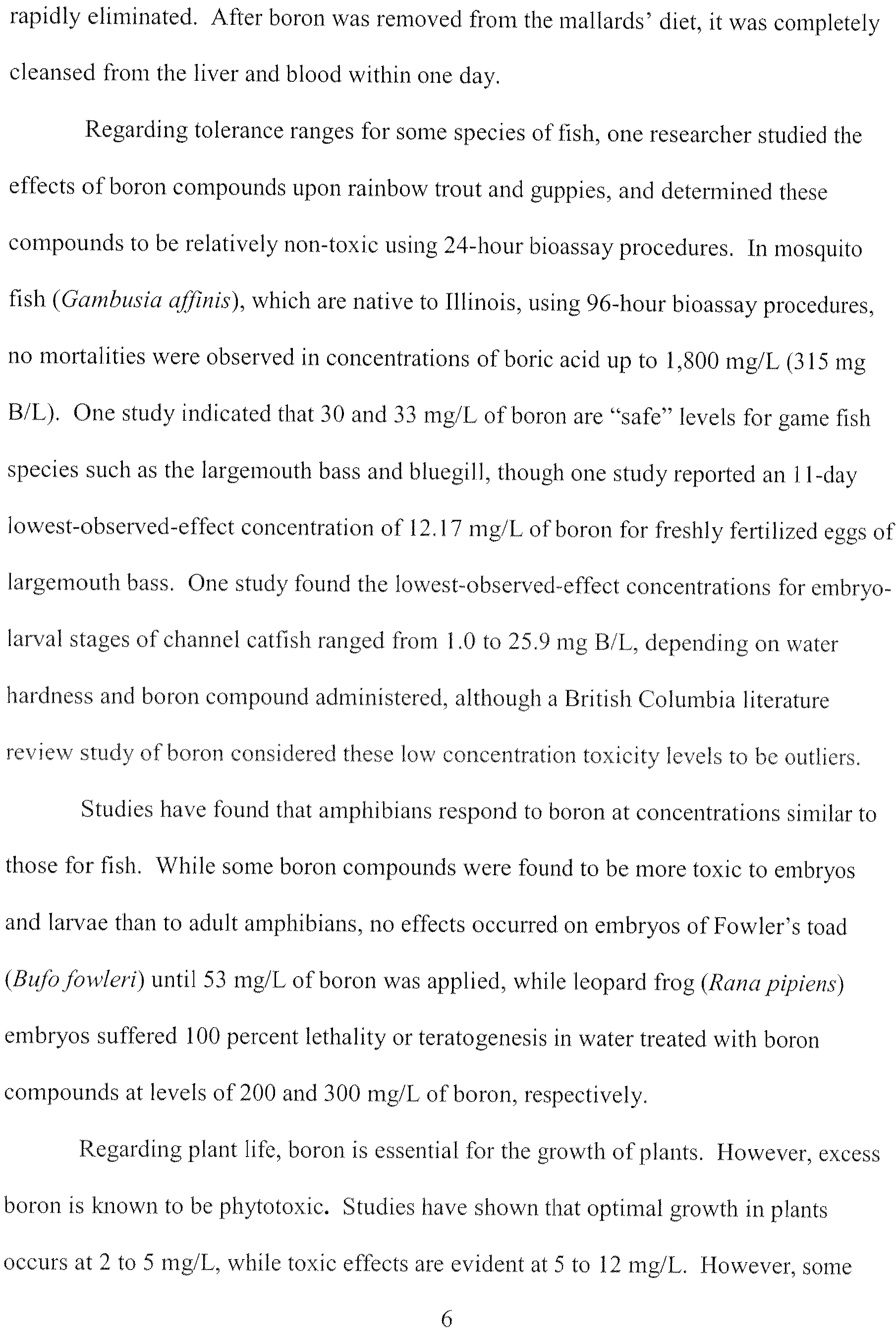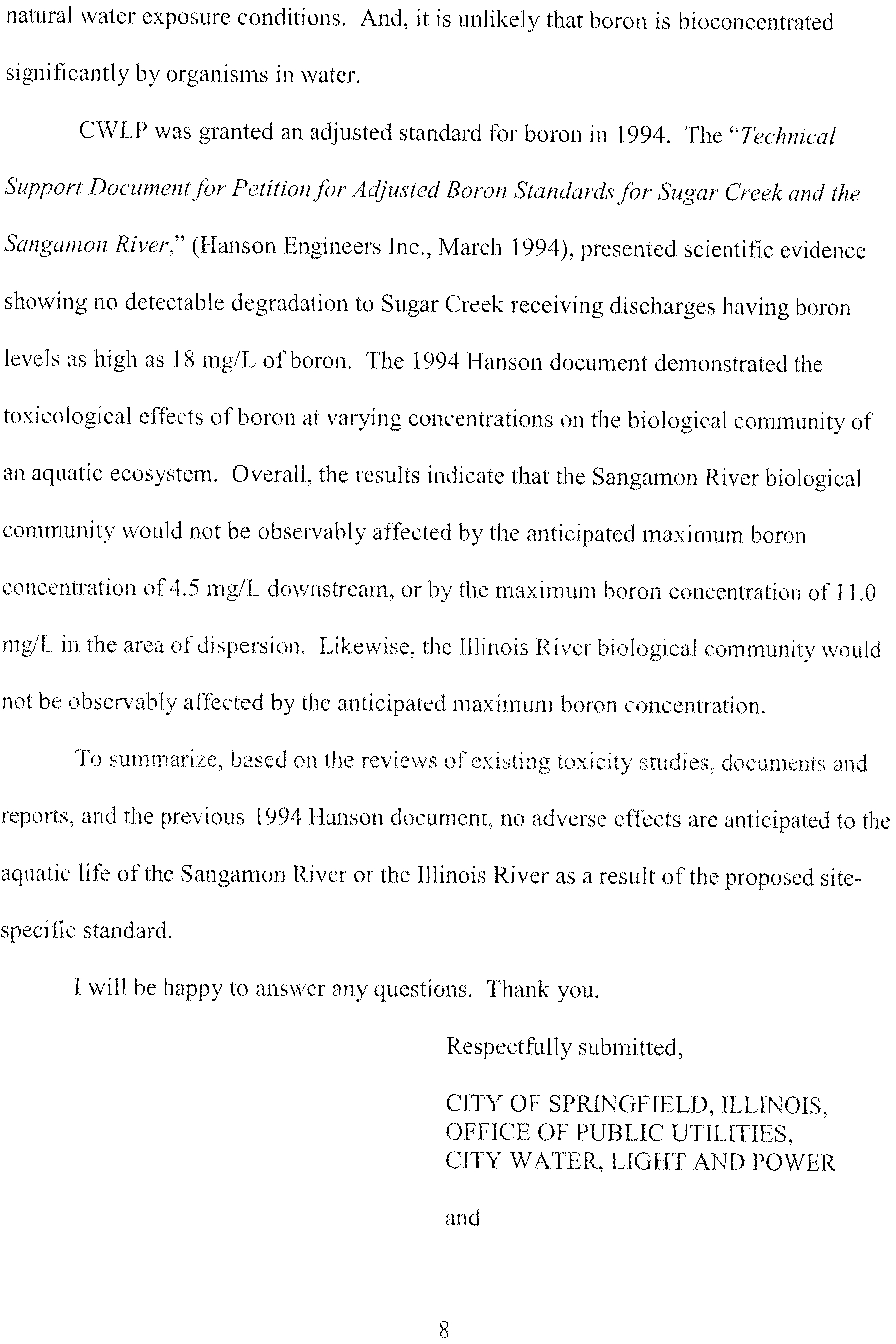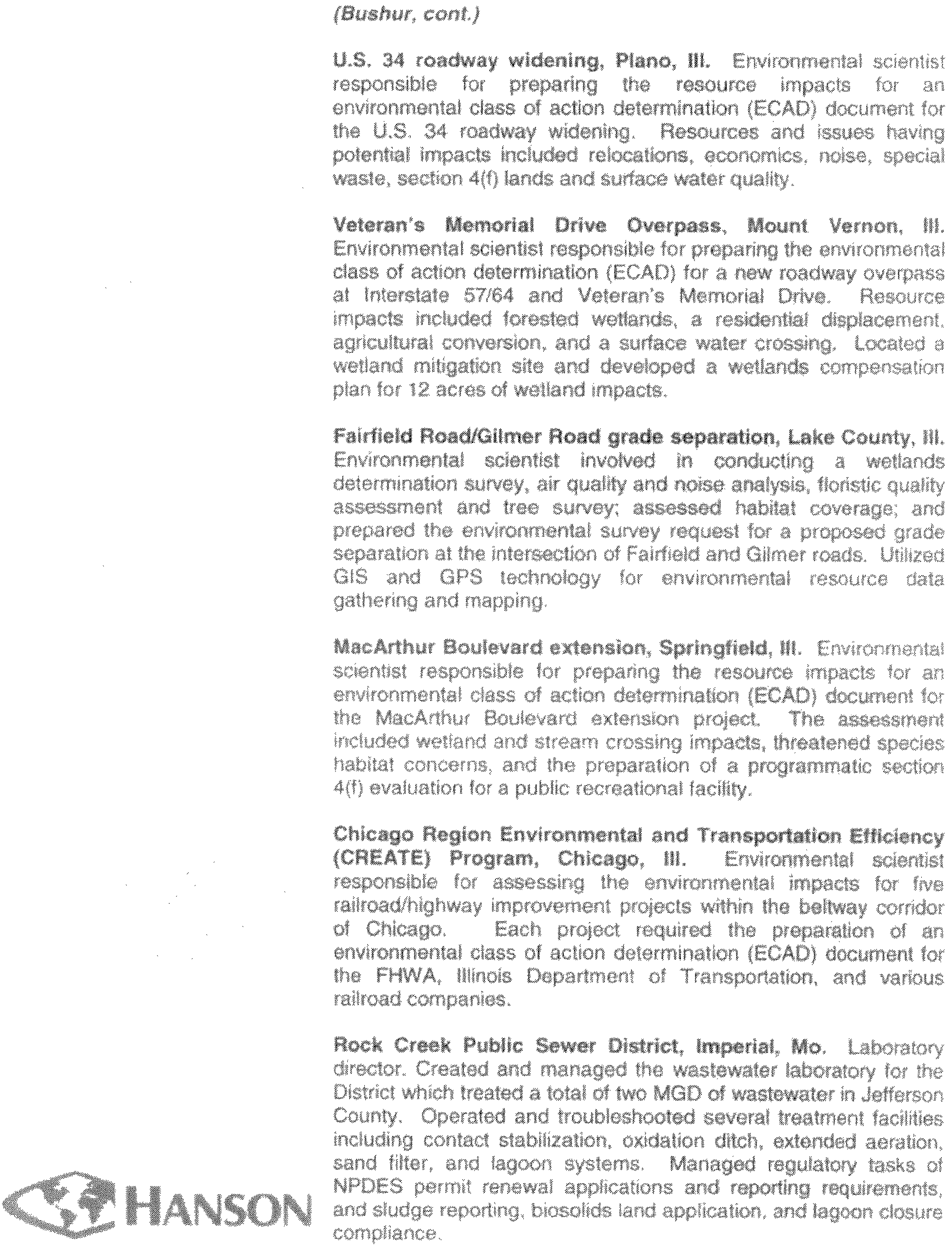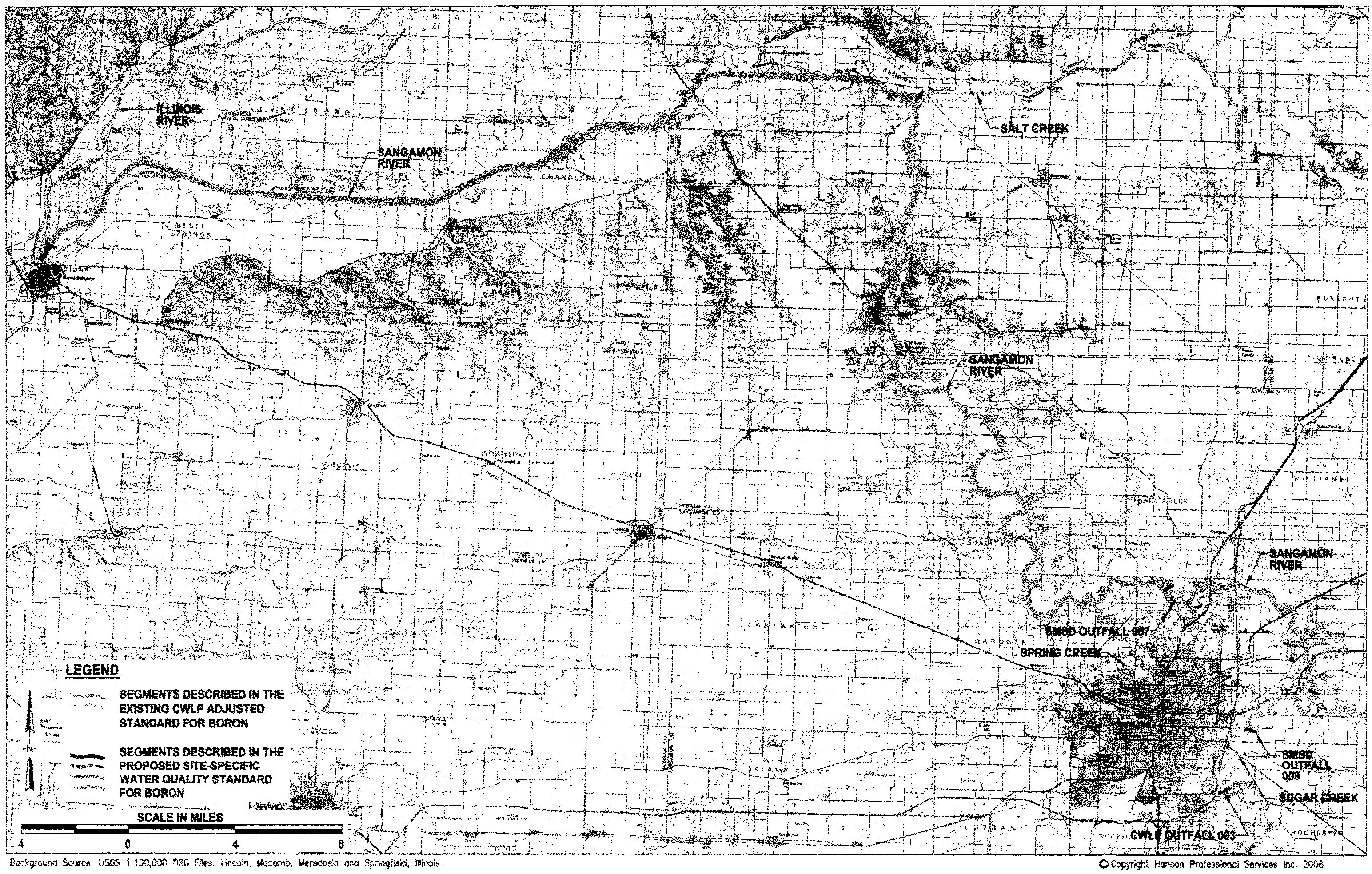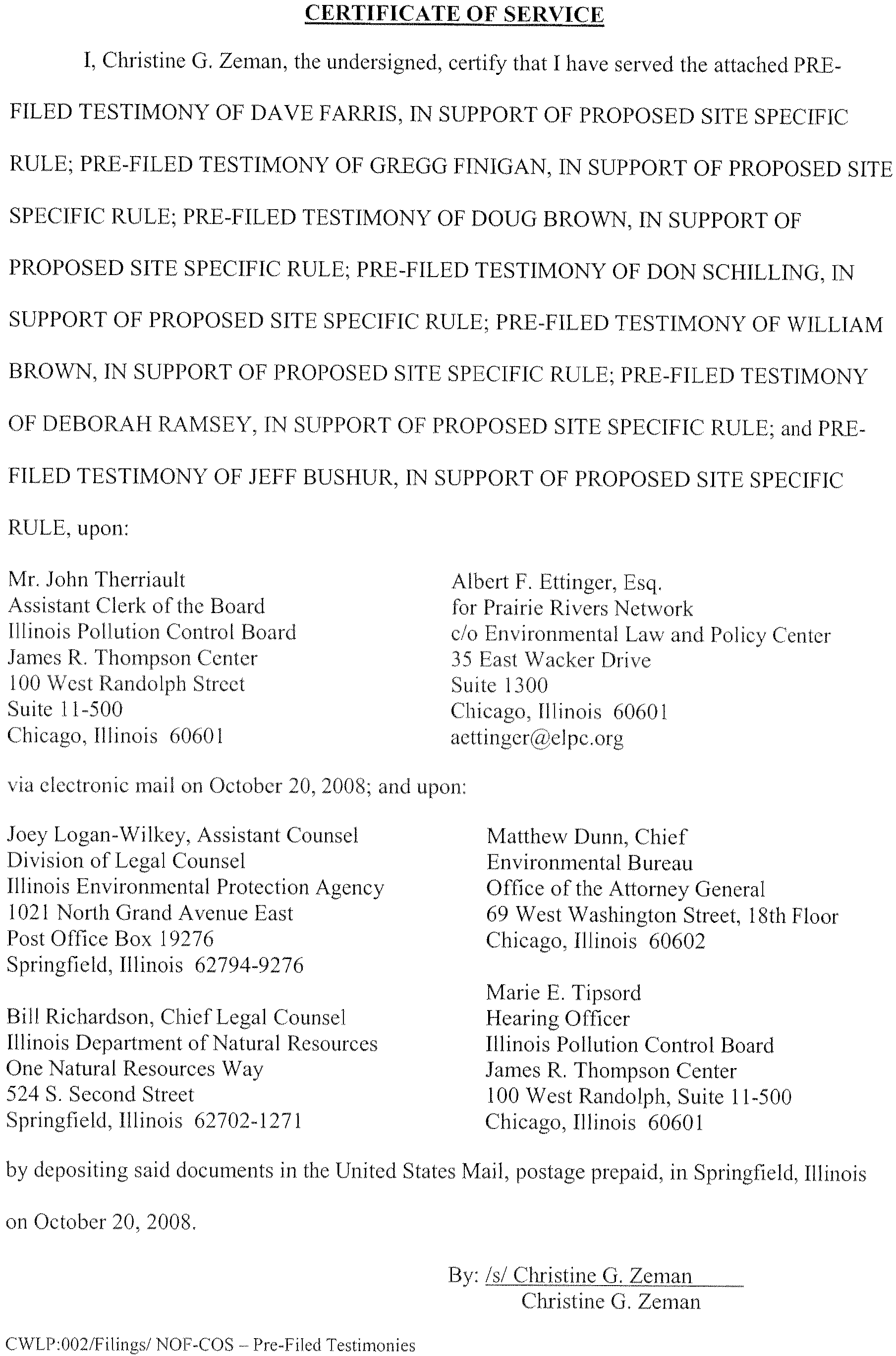TIDE
F:
PROPOSED
SI
S POLLUTION
CON"
RULE FOR
CITY O
ILL
R09-8
(Si
Office of Public
Utilities,
?)
nd Power
collectively "Petitioners"),
by and throe
nee
as a consultant in the powe
Hearing
Officer Order,
e-Filed Testimony
of Don Schilling
the above-refs i
rnatter.
K ansas City,
Science
de
chilling. I am employed
at Burns
ri, as a
Senior Associate Chemical Engineer.
I hold a Bachelor of
-five years e
itary District
CAE
DWY
sas City.
t imony t
t reatment techno
i
Iic;i uncut, My
current resume is attached.
ncerns Burns`
study that included the review
of boron
considered, their relative
effectiveness, and their
Electronic Filing - Received, Clerk's Office, October 20, 2008
costs,
as well as Burns
significant, either requiring
greater than 95 percent
removal or
In
March 2004, Burns was contracted
to investigate
options available to treat
FGDS wastewater for the removal
of boron from
the FGDS purge stream. The level
of
boron redu
requiring zero
") for
CWLP's Dallman units.
capital and operating
cost
study was a
uat
p ond system
that was
provided pot -ru al me
rage from the FGDS. The purpose
of this study was to identi
igation
of the sources of boron
in the Dallman/La
erformed by Hanson
of the impact on the
flue gas desulfurization
system
mart' source as the FG
of
in ýýii,
ýý-art for consi&Lat.icn,
but did not compare
costs for
the cost comparison, Burns did
provide capital and annual operating
cost
A table summarizing these compa
rovided
by equipment su
1's
it 1 in this
offered the lowest comparati
cost.
`.or ("B("')/spray dryer system
removal processes that were evaluated included
selective boron ion
ange resin,
2
Electronic Filing - Received, Clerk's Office, October 20, 2008
/coagulation,
reverse osmosis
("RO"), and mechanical
evaporation. In
addition
to the above treatment processes,
Burns investigated
options available
to dispose
concentrated waste brine
th at resulted from the
atment
Each of the
uld produce a waste
brine, which consisted of e
neratron waste
trom the ion exchange
process, concentrated
RO reject,
from
the BC evaporation process.
Options that were considered
included
conditioning waste fly ash and
disposal using an evaporation
pond. At th
study, there
was very little literature or experience
available regarding
treatment
or boron remova
reduction and clarification.
. Most
of the FGDS treatment processes
targeted metals
h a review of availab
Ie
that b!
_
the
removed
using a weak base
for the remova
ron-selective resins
are typically used
1_
r_
Ily a few parts per million
There was no literature that discussed
treatment of waste streams
containing several
boron level seen it
resin suppliers, high chlorides
concentration and low
ron from
drinking water su
val of'boron. The FGD wastewater
shows both character];
(high
chlorides and low pH), thus boron
ficiency was not expected
to be high.
Electronic Filing - Received, Clerk's Office, October 20, 2008
lutions of acid
and caustic are used for
the
regeneration
of the resin, produc
waste stream
containing a higher
concentrat
boron and neutralized
salts from the regenerant
chemicals. The
amount of wastewater
boron level of 400
ppin in 175 gallons per
m
oron i
owdown. Based
on a
gallons per minute
("gpzn") of FCDS
blowdown, the volume of wastewater generated
was
ated to be about 80 gpm.
This
wastewater stream would then
be treated using a BC
and cry
waste product. This
treatment option was not
recommended because
of the lack of
operating experience tre
I
the large
amount of demine
1' r
a erated.
Comparative
tionable and would reel
M :
o f boron is un
company that produced this mate
recipitation, but indicated that it
is more applicable at
also unlikely. Hanson reported a commercial
ial
is no longer ma
perform. Thus,
this option was not recommended for
further inves
of boron (2.7 percent
at 32 T, and 40 percent
at 212
ur at the concentration
igh levels
roduct failed to
aluation, a program was
initiated in the summer of 2007 to
sample the
Electronic Filing - Received, Clerk's Office, October 20, 2008
t
plant at the Homer City Power
nt. The treatment process consisted of a two-stage lime
softening/coagulation process. The inlet boron concentration was reported
to
be 224 ppm
with a treated effluent boron concentration being reduced
to 191 ppm. This removal rate
of about 15 percent does not provide the boron removal needed to achieve the boron level
to discharge the wastewater from CWLP's Dallman units. This removal
also consistent with the boron removal achieved using the Dallman FGDS blo
clarifier.
atment
evaluated. Because the FGDS blowdown is saturated with calcium sulfate as well as
ntial foulants, the convention
the study
1
0
treatment with the RO. Beg
the waste stream from the HERO process contains
sodium salts
and not
calcium
and magnesium chloride, the waste steam could be treated
tallizer in
lieu
of the spray dryer. Because the HERO process does not
produce as concentrated of a brine as would be produced losing the BC, the brine flow
rate would be considerably higher. Like the other treatment
options, there
was
no
not
ended due to
higher
evaluated cost.
declined to offer this treatment process for this ap
for the HERO
t fouling of the
Electronic Filing - Received, Clerk's Office, October 20, 2008
wastewater, and the
supplier has decided not to offer this
process for FGDS treatment
ations.
n
50 percent BCs
followed
by two 50 percent spray dryers, BCs use
an evaporation process to
separate and recover
clean water (condensate)
froze the wastewater brine solution.
The recovered water is
high-quality, and may be reused in many power
Ii
aporated in
a spray dryer. The most
mechanical vapor compression ("MVC")
cycle to pr
be bundle
,!."Js ("TDS")
and total suspon.!,.:! lids
. A strean'i
of the concentrated brine is continuously bled from the
system in order to
content so that tllý . ,tcrn
scaling is minimized and the uni
ation approach
wh
ors are available.
One uses a lime/soda
ash softener to pretreat the evaporator feedwater.
exchanges the hardne
ions. The concentrated
of these
use a
The brine is recirculate
ost of t
for sodium. The advantage
of softeni
ing
ed from the crystallizer recirculati
if the feedwater
were
a
6
onal capital cost, of the lime
Electronic Filing - Received, Clerk's Office, October 20, 2008
oda ash feed equipment,
softener, and softener
sludge dewatering
equipment. This
process also requires
more space, which was
not available and
produces an additional
solids
waste product from the so
uses
con
. The second
aporation
method
feedwater
to the BC without soften
of calcium and magne
eadily form
crystals. A crystallizer can be used
to further concentrate
the brine
but the final
bri disposal would require the
use of a spray dryer.
Some previous experience
using
w it
f'.
The
goals
of the FGDS treatmen
brine.
re
r.
c d
fro
chloride. These
salts are very soluble
and
owdown was
ne of the
at was used in the design
of
oblems,
the conclusion
"[t]he unit ra
such
as boron, in t
tier
than allowed by product specifications.
)ject. However, if the
impurities levels can be reduced,
trld be achieved." The failure
of this
demonstration was
that a commercial
rrr
chloride brine) was not
achieved.
vended
by Burns and purchased
by CWLT' frorn
Demonstration
Proje
aced modifications designed
to overcome problems
Electronic Filing - Received, Clerk's Office, October 20, 2008
encountered
during the Milliken
uded:
roject.
of
" Low speed vapor compressors
that operate
at 4,000 rpm in
wo-stage mi
inators
to eliminate brine droplets from
becoming
r.
" Improved solids removal
scheme to allow the
operator to easily
olved ar
Upgraded materials of constru
n
-.;
a 1 pirient
suppl
D ual perforated plate distribution
system for improved flow
distribution o
ater ti catment options
) ltiI
,;s
e,ý'4_
)
I [ý:d
to have the most
poten
s tream with
the
fewest
problem
eatment process and
the desi
of the
I 11
tat
n ot to generate the addition
solids from
y dryer in lieu
of
r. During the detailed design,
-ay dryer.
onside
ned major modifications
the
higher grade
chloride resistant
s determined that the sol
generated would have
a relatively low density and the r
ificantly larger than first anticipated.
'The difficulty of handling and
disposal of
duct resulted
in the abandonment of this treatment
option. Thi
8
Electronic Filing - Received, Clerk's Office, October 20, 2008
osal issue
would be applicable to all
treatment options considered.
Althouh
ri the
solid waste from the l3C/crystallizer
would consist
calcium and magnes
m the lime/soda
for pretreatment.
the volume would
be much greater
due to the sludge
the Illinois Environmental
Protection Agency
requested
CWLP investigate the use of electrocoagulation
("EC") to remove
boron from the FGDS
waste stream. EC uses
charged plates to introduce an
ele
es a driving force
for chemi
stable compounds or coalescing
charged parti
method of removing
t; how,.. vci
ec
instead
of
the
wastewate
ing more
larger settleable solids.
be fully explained
by the suppliers
o
n
(acmonstration r1lot was performed in late spring
of 2007 to
ý1",
volts,
plate m;-iL:i
i<<1.,,,
gated variable such as
amps,
not a preferential
o n) .
p ilot test demonstrated that
this proces
ially in
onstration
and the plating of the
electrodes with
salts will cause the system to fail within a
short amount of time.
l be happy to answer any
questions. Thank you.
Respectfully submitted,
and
Electronic Filing - Received, Clerk's Office, October 20, 2008
Date: October 20, 2008
DISTRICT,
a S ANITARY
B y:
_/s/
Christine G. Zeman
ý
One of Their
Katherine D. 1-lodge
Z ernan
3 150 Roland Avenue
P.O. Box
5776
Springfield,
(217) 523-4900
is
62705
CWtP.002/F0/Pre-Filed Testimony of Schilling
Electronic Filing - Received, Clerk's Office, October 20, 2008
Project
Consultant
for Water Supply & Wastewater
s r,rlciate Chemical Engineer
with more than thirty years of
cc in water
and
ý ý'aýtCtý.ater
treatment. His areas of e ýperti5e i
s peci(wation, and procureinci t
of
Cheniical Ti-catntcnt
Sj
sterns For
Industrial Facilities
and PtlNer Phint Water Treatment and Wast>:ý+ater
Trcmnicni Sý st:cms.
He has
speclalllcd i"\perience in material selectloci, ctrrmtilou (ontrol,
do>alination systems,
waferlrcatnwnt systems, ion exchanirc hroýr.;c<,,
avid walci cheiitical conditioning.
Mr. ScIitIIint_liasliartisi1)medinIll ir,I ;itinumerouspower
projects andprovided
dc-ýl
i, 1l al
i rFri-Iliý r t-;il"l( if"'.
RcýI)un
ihlc° Ikir the dc,,l,tn .tnd proýt+rcmcnt of v.-ater,ind ý..I-;tc?atcr
irk. atment systems
" 1". ,IIý L'
Treatment
for ýa ne\N- 8ý0 Nlltv'
coal tits
Iced
ýLCaiu ;ýcnk-r if ill unit- TI i. nc ,ti unit
&ý,ign incni Ixirates
lý aý:ir Water
Treatinent
an F61)
I,Ioýý
do%vn treatinc'lit system if h) I-J ikf
t i,ý
fin-
tu,.ccI bl<Iwdo n trN-lclII,-
+ý ChclnicalCondititlnin,2
zero liquid dr,clar --
" VvaterQuality
CoIiirot
" Material
Selection
7
tic crlng,
ý ,' I I".<irll l
ý .(IhcICrij
Unit,
Cmrtnd\
I 11 '( t
;' o
s ystems
t l":I ;tll;r
burning
J:"
,1
I
ia'ln
( I'R
P 1
I .ýr1Ii.
!41(I
%M
'
I) 1ý.',
) ;Ii
d
t ;w!c_-Plll<ll studlcý: t it ýt,t.'rlrýIU2
ý
: d ditiOft 1l %,3t t (r.'atm.rlt,, i ci ii
U ili`tni'lf',
1ora new f
-;()
R1W
' Cu- 7I
f tlý..'li j ;
tC'linl ? Cnk_'ratmgunit.
Prep!,'t'J F'
c iic:at
W
, ,,
for the procii liicut
of tfC
ýý;t(ý't i I k;af,iciit
equi
!I
e nd r1,-< h. I,iyd
fitn f?()ýv r
( i" Idlli°
. -Itý`
i
t,'t711:Ct11llal
_ 'ii itlr lh`_ r,iCýCIU1?Ilil'tll:
of R 7. t1M\V
I wail l 1iGd 1!illt.
.I
Itc ý,,
;1es a zen., di,ccorlccl,,t
fllr the new
K cspunsi(ýIc
fbrille
il'+eik:ýý
ýý of J I'! C. irtl:iý-i(ýr ýIhri iýl.l, 1,,( the
ticimient
s ;
stý'il1<.
far two 750 %lW
coal fueled unity
ýlajur ýs;iiertrc
atnt,'nt ct.ti±i,)in;ýnt
includes
r<m wafer
Clarifier/softener, reverse osmosis iw;rament with niised hi°d.
drniilirralirý'r,
A -,
t l
o ý'I CKCS: L .nfLrIU::CI _
i
lk-'
d C',Wltc`d, md pro ctifoti
vt.iwr ti ca
il
m:
'llt
c
oli`,IýI
r
rlg
Of
1 lrlift ifn(.'1?' Ii':ctt;ý: ý ,lrtt'J<
I0ll<il,ýA h
\
elCC trodc iorlllation, C 1,:
and,
: ..I.-
ýIý
ý r c hcnuc.li Iixx1- aru! dl,` i;tmple
alit
a
nalysis ;tk°Ili
Elc
t`,'a^, 7iýsr
' ýý 1: a t'",
tit _
I rlýllli:cr.
He reviewed,
o",ign
o f
water
irC-Eiinre
nt,
".3v;tco.ilcr treatment,
and c bc-ntlc;d
< oiiift loiiing
systems as the ()`brier's I l i¢
iir for
i
ltccomltitiedcycle
gaspmvcrh6nt, IIl-.
dksignincluded
vva,,iý.-,vatertreaunt'!!.
l;icilil ii:; to
allow zero di chýth.:. ortt
ri(tioia.
Electronic Filing - Received, Clerk's Office, October 20, 2008
the combined c kýcle
,:AtnVcrs
1n _
Cl do
il
klcJt_I I c i1 a i i . 1 jocured water
treatment
e
o
n,
inc 11(dir} , ?-pass
reverse osmosis system, camp
d
:md t ir, ul;1tii0
,.;;lier ii+-lili(,tl
)l ý ýl,.
l-fe \ý'as assi:..neAl as ti Prc,ject I'rocesc Engineer. He provided envýineeri
di°`,iý_ n c)1-'v+ttu r trc° ttn'+cnt :Ind
ý!tcr conditioning systems as the CIý> ncr`,
Fagincer
for
I)
I
II, ,] .
_ i,
_c+l m
i1!
A s a
I'rowct
fýr(AýCýý I_nsiiwcr. Ile ( I C';i"-rler.i tII)d p rOCUrcd
% k-<
ti t:r t I_airrnentsystem
con,,(Stu l,_, U hf=rCý`ný.1i91i'1 Illtý'r:; iv'-'!w t!,nio,; , tt't';1t11wni !,sl!t?<tt'(1 by
electrode
iomýittiun.:,artlt)Iine tArld ;trial`.ý,i ,`.>tt!rI. ci!'c.tti,rtltle }::Ier ¬;Ilt`Irtic,al feed, and
chemical hcýl ;`:stair`; lur[hc C'iAnilý+inecl (
lcic
1'rý!jcct.
(
-t7'1'.I`Itlll.'.
()f
1CCi'!"ýc
(3
: Ii!i;.i. t:
l cr!t cti
R, 1\,.l
t iI+'r
',,11,11
' C
r.:lic'n)t<'2li
iC'l;f ElI1;.i c'"C'ii
i,h_°ilLf
,71 !. "'C! 1,
r. Sc
I1 I!in lin+ý tit:.3 c!c-týrrl
of
ýtar:r llrhl t, ,
,I 11
Merit laýliitlt
follo',girl" ctt;tl-lirti'ii+-mlts;+ýthcI:I,("t:t+ntlctct,,r
ntlu&+,lcl_>.t_t(
procuft'Cr7Crll, '-;it+SttI1L (tl)(l C
t-+t'!1nfi:ý.tiinrlitlL-
JAU'--A Tinier, I'sitwi Povi:i l'rctjcct: I'aitan.-
lndonesi;r
-lIle
F PC scope inc
sý:
lu;rtc r
uc';alirlt!iiinl,
c
vek
n1;Ik('rrl)
rrcatrnc!lt. c+lndcrl`,ate pf)li,hcr;,,
elcctn,A:hlvrirlatitm. chemical Ic c;1. sarnlt(irl:_ ýý,stzm . s rld t ,.ýt,lc°s4atcl treatment
for
he,ivM
m
etal:, r c
mc týa
l
1-v
Ixkrt O ý o
;'11k
:o I1-h r+'d tink",. M r- `ýchilline <Ilsi)
provided ( w-S ite ,tarwp a nd comrrl I f,Sro nin^ : A"-ýIVfý1nCe
1tlr
i111 1t:r l -'r rrv:!rment
systems.
a PovcrCompany
-Taichunl Pover-tit;aictr,: Taichun!ý, `l
aiv,iin:
'The EPC
scope
inclttidoi
tr°f°<rf(rtclit oil-tllr
c,.ati;tetý°lrcr
ýrcneratý+l ht'tiiý 1lrlt' +,=aý
d l'ýIIlItll'!%1liw1 "I.,.`;ti.'tn ("'r':1 !ilt 4'.Si,ll Ill" lul
% t;v, rlec;hlrc!
týl
cllaitrlifý;
tlr_-
tt1)t:rsi([pn
ihthtý
Lr< lilts ,[
t lnllit, '1;;}It±J
I)+rrýý?Iý':'a ltrtf,;f
irr;
t',C :I¬l,=_o, .<,r c ieyl, .rlidwli.'velopwater
n l;trl,lý'cnlrlit
pt w?r;]llr, or ln,+
sii,ý;ctc
pr-,
lbl rn r!s!+t-ý
i;.tlt,(f
a-itll
('nr,t)siun (,,r plant
nl'r,_r°atiftrls,
l ý(I<Ie+Ir i,, all eý,;tnlpl<' rýf
,.lu(iv
p+ riitru+Cci tora! tldii-tu1if hrc
Chimt Li ilt
ý,,
Ii C(iIllpztn;: -- C;r,!k Pi,
,I!ý
Poo,: r Station; Hon;,! Kaltg.
prcil:rrtil,,i ý.ýa',tl llrrllawr., nr¬`ui:-.ttlfr,l
a4.`.tjfJlMLi g¬'rtet;ltin! facility.
The
I tYrl V ,lt9i';tc:`d ¬ 3fCIti11t.
r:(&
!l-f1.!Cled k ttlll`" t ir!tl
nlllýfil`I:
'
,ý'aSfC+
II fiR"li: al S_'()I'lll)t1ýStEOn
Electronic Filing - Received, Clerk's Office, October 20, 2008
eater mmiagement
c ONIYpliance
with new
. Schi}lin!ý
r
nýrTaýýcdthe
Study.
Electronic Filing - Received, Clerk's Office, October 20, 2008
BEFORE TII LAOIS P OLLUTION C O NTROL BOA
RINGFIELD,
BLIC
IGHT
)
R09-8
FROM 35
ILL.
SECTION
302.208(g)
tilities,
LED TESTIMONY OF
collectiv
0
1y "Petitioners'
of Springfield,
is
")
and
Springfield Metro Sanitary District
their attorneys, HODGF D
loved at Crawford,
Murphy & Tilly, Inc,
my-e ight
years
of
e r treatment, engineering and management. I hold a Bachelor
of
ity (which is now known
of Illinois at
ek Wastewater Treatment
ORT OF P
tration
from
a nt ("Spring Creek Plant") operations; the
S
Electronic Filing - Received, Clerk's Office, October 20, 2008
utant Discharge
Elimination System ("NPDES")
Permit anal
econ
the beneficial impact
to CWI-P of utilizing
SMSD's operations;
and the
ilizing SMSD's operations
on CWLP.
SD owns and operates the
Sugar Creek Wastewater
Treatment Plant ("Sugar
x)73, a
fro
as. T
was constructs
eld,
Illinois. The Sugar
Creek Plant
stewater
and storm water
from the southeast
1t
astewater
t, west and northern parts
of Springfield and
ice
areas. The last major improvements
to i
0,300
and
increased just over one percent per year
on average for the previous
hzdge treatment
plant
a, and
-ing main unit processes:
Grit removal for removing heavier
sand and grit particles;
removing somas anct wotogical
matter;
4.
particles
olo
clarifiers
for removing the remaining fine
solids
from these clarifiers
to the
n tanks);
Electronic Filing - Received, Clerk's Office, October 20, 2008
Anaerobic
sludge digestion to
stabilize primary and
secondary
Excess
flow clarifiers to pr
flow storm events.
The
Spring Creek Plant
stored (biosolids
are land applied
when
the River, flows
into a 72-inch diameter
is conveyed
approximately 5,9'
all sewer was
constructed in 1973. The
7-day 10-year low flow
Plant discharge is
54.5
ilion
gallons per day
of the Spring
Creek
seasonal disinfec
of
ays per
and is
operators fiom 7 a.m.
to I 1 p.m. There is a separate
design capacity
of 20 M
2004
through 2006 have ranged from
11.8
The
design maximum flow of the
S
Plant for.- complete treatment
is currently 50
ours
per day, five days per week. It has
an average
005 peak
of
98
Electronic Filing - Received, Clerk's Office, October 20, 2008
On average,
the discharge of the Spring
Creek Plant is less than the
7-day 10-year
low flow
of the receiving stream, the
River, which is 54.8 cfs
or 35.4 MGD. A Spring
7-day low flow
of 11.31 MGD has been used
for calculating the boron
r the scenario for the proposed
Site Specific Rule.
This flow rate is
based
on the 7-day low flow presented
on the 2002 1SWS map,
the latest available.
effluent flows as low
as 9.
2007.
observed
during an atypically dry September
The requirement
for complete treatment of flows to
the Spring Creek Plant is
("NPDES Permit"), which
expires
, 2009. MSD anticipates there
will be change
upon renewal.
By July 31, 2009, its current expiration
date, construction of a new
it: hf,uld be underway, which
will require
Permit due
the reducti
tion Agency requirement
uncut facil
influent data, the carbonaceous
BO
concentration ranged from 157 to 214 milligrams
per liter ("mg/L") with an average
of
172 mg/L. The
CBODS removal after primary, secondary and tertiary
treatment is about
ent CBOD5 of approximately
3 mg/L.
ation ha
307 1ng/L with an average
of 198 rug/L for 2
.Ltý:aal had
only 7.3
SS on average.
Electronic Filing - Received, Clerk's Office, October 20, 2008
eek
r e
nfluent value of 12 mg/L to 1.35 mg/L in the tertiary effluent
percent removal. At the present time, ammonia nitrogen loath
-ing Creek
um capacity, but recommended plant improvements will be designed to
provide ammonia nitrogen
Total phosphorus remo
ES
so influent and effluent data values are not available, but plant expansion
uirements expecte
low of 50"1i to
a high
of 78'F
in 2006.
5.0, on a,rer:ý
plant
i 1T,ý
Spring Creek
gas
desulfurization system
") wastewater
1.31 MG
not be si
process, and there
ational adjustments to the
sonal h1PDES Permit
ammonia nitrogen. Data from 2006 shows
a reduction in ammonia from
he 7-day low effluent flow
7
concentration. Thus, the Spring
Creek
Electronic Filing - Received, Clerk's Office, October 20, 2008
ed to be 1 1.0 mg/L.
The boron concentration
downstream in the
River is
estimated to be approximately
4.5 mg/L under
this scenario,
ently meets NPDLS regulated
parameters,
to the Spring
Creek Plant is not
expected to have
any effect on the
Spring Creek Plant, other
than the increase in
boron concentra
effluent. While granting this
Site Specific Rule will
not reduce, with any level
of
ty, the need for
the previously-granted 11.0
mg/L adjusted
standard for boron,
rather, granting
t
ay enable CWLP to meet
compliant levels is
the FG17S
wastewater stream, at a
00,000/m
1) ,, of the
estimated
by CWLP. TI
1 cost
o control odor
to the
nce
ficantly less
than the brine concentrator
other
O & M costs will likely e c;lý,t.ý.
Using a $10,000 per year
escalati
which is estimated
to be at least $1 .6 million,
factor, a pretreatment life of 30 years,
and an interest rate of 8 percent,
this equates to a
present value of $36,100,000,
a present value per electric
service of $544. In addition,
the plumping
station will occupy significantly
less space than other alternative
1
or hazardous waste product would
be generated.
6
Electronic Filing - Received, Clerk's Office, October 20, 2008
For the pretreatment
system, operation of
the patented ClariConeTM
has been
ClariConeTM
over 300 installations nationwide.
Mixing, tapered
flocculation and
all take place within
a completely hydraulically
driven vessel.
The
s
a dense, suspended, rotating
slurry blai
contact,
accelerated floc formation and
solids capture. The conically
shaped concentrator
d allows plant personnel
to visually
monitor slurry
discharge. The large mass
of retailed slurry and
unique helical flow
iting
and resists process upsets. While
laboratory jar tests have
shown in some instances that
ten percent of the
boron in the
wastewater
can be removed with solids
settlin
n
urposes of
calcu
Plant:,
fiberglas
n this
I ?,I Ird pump
in ate,
1
ý...... A 10" diameter
g station to a sanitary sewer
generally
west of
,astdale
Avenu
part o
crossing
Stevenson Drive and Sugar Creek,
to the CWLP Tansey Road
electric
substation. The main then
turns northwest, bored under
1-55, and along
Electronic Filing - Received, Clerk's Office, October 20, 2008
is
ant icipa
a nd sever
release valves will
be required. Sealed and lined
size
odors and corrosion.
Lining of the receiving
manhole
t of the existing
sewer is anticipated at a minimum,
or more chemical feed
sites or stations as deemed
ing
Creek
wastewater
from a large area which
Thus,
the
WLP wastewater
will typically be a small
y two-
ill not requi
I
will be happy to an
ction of the total treated
any capital expenditures
by SMSD.
respectfully submitted
2008
nd Avenue
P.O. Box 5776
7
;TRO SANITARY
e of Their
Attorneys
:002/riliFlre-
Electronic Filing - Received, Clerk's Office, October 20, 2008
William A.
Brown
S
enior Project Manager " Crawford, Murphy
& Tllly, Inc.
M
r. Brown recently
retired as Su-
perintendent of Water
Supply
& Treatment
at City Water, Light and
Power,
Springfield, Illinois, where
he
was employed
for 20 years. He has a
to-
tal of 28 years experience
in water treat-
ment,
engineering and
management.
He
has a keen understanding
of
city, county
and
state codes and
regulations. He was
responsible for
operations
in water re-
sources, water quality
and water puri-
fication.
including lake and watershed
management, new
water source devel-
opment and dealing with property
and
agricultural
issues. He taught chemistry,
mathematics and
principles of operation
for
waterworks operators
at the local
community
college. Prior to working
at
the treatment plant, he
performed chemi-
cal
and microbiological analyses
on
wa-
ter and wastewater
with State of Illinois
certification,
technical project
manager
for various
lake
and river water quality
studies,
water main
and sewer
design,
facilities
planning reports and
construc-
tion inspection.
Professional
Credentials
Illinois
State American Water
Works
Association:
- Recipient
of the Thurston E. Larson
"Best Paper
Award"
1999
- Recipient of the "Operator's
Merito-
rious
Service Award" 2001
Illinois
Potable Water Supply
Opera-
0
0
tors Association
" American Water
Works Association
" Horse
and Brush Creek Watershed
Planning
Committee
" Class "A" Water Works
License in the
State
of Illinois
State certified for
microbiological
analysis,
State of Illinois
0
R
elevant Project Experience
City of Aurora,
Illinois
Assisted
the City in resolving operation-
al problems and problematic
treatment
of Fox
River water.
City of West
Chicago, Illinois
Assisted the City in start
up of new 9
mgd lime
softening
water treatment
plant. This is the
City's
first ever water
treatment
facility.
City of Springfield,
Illinois
A s part of an alternate
water supply
study,
ran a
ClariCone pilot plant
on the
Sangamon River
to determine treatment
requirements
and techniques
during
drought
conditions.
Sampled and tested
the
Sangamon Riv-
er and adjacent gravel pits to determine
water
quality
during drought conditions,
normal and flood flows. Discussed
fu-
ture
lease/purchase options of the gravel
pits with
the
owners.
..%f:
s
ýjýbý
Electronic Filing - Received, Clerk's Office, October 20, 2008
1 THE ILLINOIS P
OLLUTION CONTRO
I N THE MATTER
OF:
pecific Rule - Water)
NOW
COMES the Petitioners, City
of Springfield, Illinois, Office of
Utilities, City Water, Light and Power
("CWLP") and Springfield
Metro Sanitary D
, by and through their
attorneys, H
i ill ý'-r I
r
eferenced matter.
ssional
Ser
("flanson") in
Springfield, Illinois. I have thirty years of professional
experience.
helor of Science degree in Chemical and
Petroleum Refining Engineerin
the Colorado School of Mines, a Master
of Business Admini
Illinoi
iversity
at Edwardsville. My current resume
i
ny today concerns the
ny of Deborah
ion from
Southern
of Science in Environmental
Science
lard for
boron; the condition of the receiving
Electronic Filing - Received, Clerk's Office, October 20, 2008
streams; the historical
flow and boron data for the receiving
streams; the entities
presently discharging
to the affected water
segments, as well as the
entities using water
downstream; and the investigation
of the flue gas desulfurization
system ("FGDS")
blowdown
as it relates to boron and its
chemistry. I am the principal
author and
"Techn i
No.
esponsible for the development
of Exhibit 1 to the Petition,
entitled
ipport
Dvcranent fbr Site-SI)ecific Boron
Standard for the Springfield Metro
4767,
ational Pollutant Discharge Elimination System
("NPDES") Permit,
ring Creek.Plant,
Sangamon County, Illinois" ("TSD").
ecember 5, 2001, regulates
16 outfalls at the
CWLP facility,
charges from Outfall 003 and
Outfall 004 contain high concentrations
of boron.
WLP to
s of boron in Outfalls 003 and
004 to
boron was 1,0 nxg/l.,
with c
iance to be achieved by Decem
Sugar Creek
a
with the general water quality
standard
of 1.0 mg/L. The "Technical Support .Document
fear Petition for Adjusted Boron
Stanclar
was, at that
Sugar Creek and the Sangarnon
River" was prepared by Hanson (which
d the A
mhe
h
ibit 2 to the Petitio
lusted Standard From
35
1:11. Adrn,
Code
quality
standard for boron already
2
Electronic Filing - Received, Clerk's Office, October 20, 2008
aters at issue in
this Petition. Figure
1 atta
shows the surface waters
covered by the Adjusted
Standard
and the surface waters and
other features
at
posed site
specific water quality
standard for boron
would include at
of dispersion
with boron concentrations
ranging between 4.5
and 11.0 milligrams per 1
g/L") from SMSD's
Spring Creek Sanitary Treatment
Plant ("Spring
Creek Plant")
Outfall 007 to 182 yards
downstream in the
Sangamon River, 4.5
mg/L in the Sangamon
River, a distance
of 3
confluence of Salt Creek with t
h the
uence of Salt
Creek with the Sangamon
1.6 mg/L
in the Sangamon River
from the
fluence
o
e of 36,1 river
miles; and 1.3 mg/L in
the Illinois
from
the con lug i iý.
ý_
of the
d oNvr,
st rt. um
The proposed site
specific
,,.,
,iicr
quality standard is
54.
concentration in the Sangamon
I
to discharge frot
Oil
" ) having a boron
concentration of 2.0 mg/L
in
the
ron concentration
of 11.0 mg/L.
s based
on the Adjusted Standard granted
to
u e
t he
terms of
the proposed site
specific
rule
as set forth in t
Electronic Filing - Received, Clerk's Office, October 20, 2008
The
Sangamon River watershed comprises
about 5,419
square miles, all of which
part of Illinois.
Practically all of
the area is tillable and,
for the most
part, is cultivated. The
Sangamon River originates
in central McLean
County, east of
Bloomington,
flowing such that it
is joined by Salt Creek,
its largest tributary, and
then
joins the Illinois River north
of Beardstown. The
total length of the
Sangamon River is
iles. The whole length
of the Sangamon River is
characterized by a series
of
pools and shoals, including
five impoundments in
its basin. Lake Decatur
is
the deepest p
n in October 2007
to characterize the general
features o the San
ownstreani
ed it to
Results reported to me
from this held survey were
as follows. The lower section,
below the confluence
o ý;; -t ii,rttion
ý ý1.=ýCJ71lýn
u psti-cam of the Spring
near Petersbur
at
-,
p ringfie
ly
d, and
two rock check darns located
ared
by the Illinois State Water
Survey
("ISWS")
in 2007, the mean flow
at the
2,120 cfs for the base period from
1948 to 1997.
During
There are eight
m dischar
Sangamon
ges to the Sangamoi
d Gravel Company;
4
Electronic Filing - Received, Clerk's Office, October 20, 2008
Park; Riverton Sewage
Treatment Plant; Illinois Department of Transportation, Interstate
Treatment Plant; Petersburg Sewage Treatment
Plant; and Petersburg Water Treatment
Lion. County North; SMSD, Sprint;
Greek Plant; Pleasant Plains Water
Plant. Other generally known uses of the Sangamon Ri
an
eation (bo
fishing, swimming).
The reach of the Sangamon River at issue
to specific rulemaking is not reported as used for irrigation of agricultural
land,
golf courses, nurseries, etc.
ations in the Sangamon River from
"IEPA") for 1999 through 2004
for three
ions on the Sangamon
fs from
the
United
Icy,
:Iti ý,]01,:1,
f ihtý
hi
four-
s
total boron
.o ý cdcd 1.0
mg/L in nine percent of the sampling events at thi
boron value c "ceeded the adj
aiida
on at Riverton was 0.394 in
tion, no
The mean boron
over the five-year period from 1999 to
2004.
s of the Sangamon River at issue show that
eluded on IEPA's 2006 list of waters where uses are impaired,
the Sect
the Sangamon River from the South Fork of the Sangamon River to pr
k (E-26), the Sangamon River from Spring Creek to Richland Greek (E-04),
the
Sangamon River from Richland Creek to Salt Creek (E-24), and the Sangamon
from Salt Creek to the Illinois River (E-25). All four segments are identified as impaired
Electronic Filing - Received, Clerk's Office, October 20, 2008
1 cause
of fish consumption
rment is polychlorinated
bipllenyls from an unknown
source. TI
identified as impaired for the designated
use of primary contact recreation.
A potential
cause of primary contact recreation
impairment is fecal coliform
from an unknown
source. Stream segment E-26 is identi
potential causes of
aquatic life impairment are boron, nitrogen,
phosphorus, silver,
total dissolved
solids, and total suspended solids. Potentia
discharges, on-site treatment
systems, ru
ýtration
of
0.25
ni
I included
in the fo;, ..l,:ýarý .
rý;r
at
0.27
fl, =v and a boron concentration
of
450
rng/L, the
gated that the
boron will not
I rC c
1,
r sely affect the
process and therefore
the effluent boron concentration is
nt concentration. Thus, the Sprin
1.0 mg/h,. The
boron concentration
182 yards downstream in t
eek Plant
rameters. Pun
L
imated to be 4.5 in
Electronic Filing - Received, Clerk's Office, October 20, 2008
expected
to have any effect
on the Spring Creek Plant,
other than the increase in
concentration in the
effluent.
on of
the boron concentration
in the wastewater
stream anticipated
for discharge by S
's dischar
economy
is a crucial power supply for
Springfield. Consistent with
the testimony of
educe, wit
m ion River
or thý. III
m-J,
River as a result
of the proposed site specific
ives studied by
CWLP.
lard for
boron in Sugar
Creek, rather,
should enable CWLP to meet complaint
levels in
in comparison to
the concentration in
of make its removal by
SMSD any more feasible
or
asonable
than the removal
d 11.0 mg/L a
Creek, as was typical prior
to operation of the Selective
Catalytic Reduction. The
CWLP
antici
tandard; thus, the proposed
site specific boron water
quality standard is
be happy to answer any questions.
Thank
You.
and
LD
October 20, 2008
By:
_,/s/
Christine C. Zcnl1,u
_
(one of Their
Attorneys
D. Hodge
l of
certainty, the need for the
Electronic Filing - Received, Clerk's Office, October 20, 2008
Roland Avenue
P.O. Box
5776
(217) 523-4900
05
P :002/Fil/Pre-Fited Testimony of
Ramsey
Electronic Filing - Received, Clerk's Office, October 20, 2008
Deborah A. Ramsey, P .E
Chemical Engineer
Education.,
*
B.SJ197&Chemi
t
&
P etroleum Refining
Enyineerir
WC*Wado
School
of W#M
M.SJf9WErMronmentae
swwosouthwn Illinois
amity
rat Ed
r<fsvilte
R
egistrations:
ProteWortal
Engk*WIL
P
al
r00
Frv68kr"
rfrX
+ý CIO" 4W4$tq*ete
zrýtirrieýt tit ratýýCL
0
CCM
Cow
off",
EtrVkOnMWteJ Committee
Arriericart Insfitute oaf
Chernk.w Frtgineem
Publlicatirno:
+
. "Controlling Sulfur
m frns
from
",1985
Ms. Ramsey Joined Hanson in 190-3. She was previously employed
as
city
engineer for the city of Staunton, Ill., and as a process
engineer acid production supervisor
for Monsanto. Ms. Ramsey
has distinguished herself as a budget-conscious,
client-oriented
project
and
task
manager. Her involvement in the Illinois
Emergency Management Agency"s Kerr McGee
technical
oversight, FEMA (Fluor) Technical Assistance
Contract
for disaster
recovery and AmerenCIPS groundwater treatment programs
exemplify
her
versatility acid bath technical and management skills.
City
Water, Light and Power (CWLP) ash pond recycling study,
Springfield, Ill. Project
engineer
responsible
for oval Uating efforts
to treat ash pond effluent andlor Springfield
Metropolitan Sanitary
District (SMSD) treatment plant effluent for ash sluicing at the
CWLP power
stations.
The
evaluation
included
a bench scale
simulation
¬3f
the recycle and reuse of CWLP effluent
for ash
sluicing. Evaluated the recycling of CWLP and SMSD effluent
back
to Lake Springfield.
City
Water, tight and Power (CWLP), investigation of
mitigation; strategies for boron Increase,
Springfield, fit.
Project manager responsible for investigations
into the source of
increase in
boron concentration at outfall 01}4 from the ash ponds.
It was discovered that the
significant boron contributor to the ash
pond system was the gypsum dewatering stream from the
Dallinan
Power
Station
flue gas
desufferization system.
CILCO Duck Creek facility permitting services,
Canton,
Ill.
Project
engineer
responsible for
,assisting in the preparation
of
a
technical support document used with a
petition for art adjusted
water quality standard for boron. Also prepared
a technical support
document used with a petition for a five-year variance to
the
adjusted water quality standard for
boron.
Kerr-McGee
closure
application, West
Chicago, Ill, Assistant
program manager responsible for preparing
environmental analysis
and safety evaluation reports, reviewed cast, environmental
permitting, process
and
treatment facility
design; and planned utility
renovations for an Illinois Department of Nuclear Safety (IDNS)
closure application. Responsible
for
daily coordination
with and
supervision of on-site construction
observer. The project consists
of remedial design, remedial action oversight
and
review
of
technical
documents.
Kerr-McGee West Chicago Industrial
wastewater facility
design review, West
Chicago,
Ill.
Project manager responsible
for reviewing drawings, specifications and
startup plan for Kerr-
McGee's industrial wastewater treatment
facility, which is
designed
to remove
suspended solids, soluble radium and fluoride. Soluble
Electronic Filing - Received, Clerk's Office, October 20, 2008
{"MMsey, cant.)
r adium and fluoride are removed via a coprecipitation process.
Observed
initial facility
startup as a representative for
the Illinois
Department of Nuclear Safety (IDNS).
FEMA disaster assi
, Mobile
County,
Ate. Worked as a
FEMA project officer during a FEMA-declared disaster to prepare
project
worksheals that detailed damages from Hurricane Ivan and
estimated associated
repair
costs
in
Mobile County.
Majority of
worksheets prepared were related to public
entities
ten Dauphin
island, a barrier island south of Mobile Ray that received significant
damage from hurricane force
winds and flooding due to the
associated tidal surge. Damages were
assessed
for roads,
sewers, sewage lift stations, water treatment plant, potable water
boaster tank, buildings,
docks,
park facilities Including
an historic
fort, and an historic lighthouse. Additionaltr, project worksheets
were prepared to
document
emergency work performed by the
Town of Dauphin Island
and the Dauphin Island Park and Beach
Board and debris collection and
dill,
including hazardous
waste,
related
to Hurricane Ivan.
AmerenCIPS groundwater treatment
design,
Taylorville, Iii.
Project
engineer responsible for coordinating design, construction
and startup services
for
a ground-water pump-and-treat system at
a National Priority List Superfund
site.
The treatment
system
included
pH adjustment to reduce the precipitation potential of the
ground water; oxidation
of the
ferrous
iron in the ground water bra
the
ferric state
with potassium permanganate; filtration to remove
the Iron precipitate; and removal
of organics from the ground water
using a two-stage, granular-activated
carbon (GAC) adsorption
system.
American Bottom* Regional Wastewater Treatment
Facility
environmental audit services, Sauget, tit. Worked for
the
Illinois
Environmental Protection Agency. Conducted annual independent
audits to monitor industrial
user compliance with the pretreatment
program and regulatory requirements,
monitored operations and
maintenance at industrial pretreatment
facilities; and reviewed
quality control
and
assurance
procedures
followed
by Sauget in
monitoring and tasting oaf industrial users. Completed
US.
Environmental Protection Agency
Control Authority Pretreatment
Audit Checklist for each audit.
Staunton
water
treatment plant operations, Staunton, Ill.
Oversaw potable water treatment plant operation
far
more
than six
years. Process Improvements that were designed,
permitted and
installed included replacing
a
prechlorination
system with
potassium permanganate. The
sand
filters
were upgraded to dual
media,
and
the water
treatment plant's monitoring and
control
systems were significantly improved.
Electronic Filing - Received, Clerk's Office, October 20, 2008
(Rarnsay, coat.)
Staunton wastewater
treatment plant, page Itft station and
collection system, Staunton, Ill. Provided
grant administration,
project
management anti resident inspection for
a $4.5
million
wastewater
treatment
plant,
a 10.8-million-gallors-per-city (rra
sewage lift station, and
a
collection
system. Interacted with federal
and state agencies as
required
by grant
agreement. Suggestions
for
design modification of collection system resulted
in
savings of
U.S, Ukraine Foundation,
SvMovodsk, Ukraine. Provided
technical review and recommendations for
improvement of portable
water treatment system to Svitkavodsk,
Ukraine (Springfield,
Illinois'
sister city).
Also reviewed Svitlovodsk's municipal wastewater
treatment plant operations.
Central
National
Bank Diamond
"E" Packers demolition,
Mattoon, III. Project manager for "turn-key"
services associated
with demolition of a former manufacturing facility.
Environmental
services performed included
removing one underground storage
tank and two aboveground
storage tanks: excavating and disposing
of stained soils observed at three locations;
and packaging,
disposing and
recycling
miscellaneous chemicals,
special
wastes
and hazardous wastes located
at the facility. Clean up in areas of
stained soils evaluated with remediation
objectives obtained from
35 IAC 742
(TACO) regulations. Used remedlation objectives
obtained
from 35 IAC 742 (TACO) regulations
to evaluate the
cleanup
in
areas that had stained soils.
Raynor Hotels design and construction
services, Holiday Inn
East,
Springfield, Ill. Project engineer responsible for
preparing
plans and specifications, conducting
bid letting and providing
construction
observation. Oversaw the demolition of
the hotel and
adjacent gas station. Also participated in the removal of
asbestos-
containing material and in
the collection and disposal of hazardous
and special waste. Characterized portion of facility
contaminated
front service station operations.
U.S. Army Corps of Engineers,
Rock Island District, Lock and
Dom 12
Storage Yard, lillooia. Project manager. Prepared
a
Preliminary Assessment
(PA)
for the
Lock and Dam 12
Storage
Yard
which has been discovered to contain lead.
The U ICE was
currently
under an Illinois EPA enforcement action. The
PA was
developed following
superfund
guidance
documents as the first
step in site investigation and cleanup.
Subsequently selected to
perform
a site invesigation (SQ for the Lock and Darn 12
Storage
Yard seeking to quantify lead
contamination at the site.
U.S.
Army Corps of Engineers, Rock Island District,
East
Peoria, Ill. Project manager. Performed
a
limited
phase IIA soil
sampling at
a
3.2-mile
levee
in
East Peoria, Ill. The purpose
of the
sampling was to determine if environmental
issues were present in
soil at the levee prior to a floral control project
upgrading the levee.
Electronic Filing - Received, Clerk's Office, October 20, 2008
smvm LIM 1 :100,000 ORG FOo,
L%woK rooms, r..ao.o ma spbprre. /n,
0
COPY
eigU! Hone Prohrbid swiew
tie. 2006
Electronic Filing - Received, Clerk's Office, October 20, 2008
BEFORE THE ILLINOIS
POLLUTION
CONTROL, BOARD
THE
MATTER
IFIC
}
OF SPRINGFIELD, )
OFFICE OF PUBLIC
LITIES,
CITY WATER, LIGHT
)
R09-8
WER AND
SPRINGFIELD
)
(Site Specific Rule
- Water
TESTIMONY OF
JEFF BUSH
ity
Water, Light and Power ("C
OMES the Petitioner,
City of Spr
etively "Petitioners"),
by and tlu°ougl
l.
wing
Pre-Filed Testimony
o
ublic
icr,
at the November
3, 2008 hearin,i,
?.Ii,
',led in
the aboN,_-r,
P'-iý_nced
matter.
is Jeff Bushur.
rs of
experience in environmental health, water
and wastewater treatment,
and
1/engineering
consulting.
Environmental
Biology from Eas
nce
a ttached.
1
oday concerns the toxicological
effects of boron and
a description
oncerning such
effects, especially to aquat
the receiving
streams and t
ial effects
of boron on the water downstream
from
Electronic Filing - Received, Clerk's Office, October 20, 2008
ary Treatment Plant
("Spring Creels Plant")
discharge; and
assessments of the receiving
stream. Further, based
on reviews of existing
stu
rts, I will testify that the proposed
site specific
standard for boron,
based upon the 7-day low flow
conditions, can be granted
out any anticipated
adverse effects to either
aquatic life uses or other known
uses of the Sangamon
River, and
that
r biological community
would not be observably
affected by the
oron concentration under this
scenario.
The methodology and approac
quality
data, biological studies and
stream flow information that
;ies, existing published literature
re,ýzardiny, possible
ical effects of boron,
and studies and technical documents
ht Company
ndards for boron, and a variance
to an adiusted water qual
stn Standard for the
ant, 4S an n on County, Illinois"
("T
ition fled in
resources
of the Sangan
the TSD.
to how we developed information
for
ding, on which
my testimony is based.
a field survey along with another Hanson
biologist in October 2(}07 to
ores of the
Sangamon River downstýc;irii -)f the
CWLP Plant
Electronic Filing - Received, Clerk's Office, October 20, 2008
discharge. Three
areas were visited
by canoe including:
north of Springfield
front
k to downstream
of the confluence
of Spring Creek, Petersburg
at Illinois
Route 123, and
Oakford at Illinois Route
97. The survey showed
the Sangamon
River
north
of Springfield and at Petersburg
to be a low gradient,
meandering
stream. The
of the
Salt Creek, appears
to have been channel
floodway in
the sandier soils. Three
structures
in the survey
that create riffle areas
which are a source
of oxygenation for
the
Spring
Illinois. According
to the
2,120 c
ed 7,00
tired by the fill
ring Creclr
was
S tLcutl1
h e confluence of the
Sand and
Treatment
Plant; Illino
ant
hese NPDES discharges
include: Clear
Interstat
lant.
Otl
nclude
aquatic life habitat and
recreation (boating,
fishing,
The reach of the Sangamon
River at issue in this site
specific rulemaking i,
rid,
golf
courses, nurseries, etc.
Electronic Filing - Received, Clerk's Office, October 20, 2008
a including
boron concentrations in
the Sangamon River from
Environmental Protection
Agency ("IEPA")
for 1999 through 2004
for three
of the monitoring
station
am and downstream
of the
olumes in cfs from
the
ited States
Geological Survey National Water Information
System were
also reviewer
The
station at Riverton (closest downstream
of the existing
CWLP NPDES discharge
location) had the highest
total boron concentrations over
the four-year period. While
total
boron exceeded 1.0 milligrams per
liter (mg/I_,) in nine percent
of the sampling
no boron value
exceeded the adjusted
standard of 2.0 mg/L of
boron,
rton was 0.394 mg/L over the five
year
sir,,ýrnj sý.,gments of the Sangamon
River
list
o
om 1999 to 2004.
-26), the Sangamon
for the designated use of fis
tial cause of fish
consumption
t is polychlorinated biphenyls from an unknown
source. Three segments
are
identified as impaired for the
des
cause of primary
contact recreation impairmen
,,k.'N
where uses are impa
A potential
1
coliform from an unknown
al causes of aquatic
Electronic Filing - Received, Clerk's Office, October 20, 2008
total dissolved
and total suspended
solids. potential
sources of these impairments
are
industrial and/or irtunicipal
point source discharges,
on-site treatment
systems, runoff,
channelization,
crop production, dams or impoundments,
and strearnbank
mod
ontaining laundry products
and sewage, while another,
although very
environment is
due to the relatively high water
solubility of all boron
compounds,
Regarding boron,
it is an element that is
widespread in the environment,
and is
distributed in surface and groundwater.
Most boron
that occurs in the fresh water
ons/destabilization. (Ex.
1, pp. 3-9, 3-11.)
rce of boron to the
aquatic environment is coal
ash. Many commercially-
mined coal seams
contain significant concentrations
of boron. Of the total
boron in coal,
lie atmosphere upon
combustion, though more
th
of boron
d
c
ity.
In mammals, while exposure to excessive
boron may result in reduced
xposed to 120 mg/h of boron, nor
at 300
ducks and
chickens, with results of chronic feeding
studies using
in birds have
been
ely studio
iets containing 13 mg
of boron per kilogram of feed
weight
cts. While boron rapidly
accumulates in mallard tissues,
it also is
5
Electronic Filing - Received, Clerk's Office, October 20, 2008
rap
laminated. After
boron was removed from
the mallards' diet,
it was completely
cleansed from the liver
and blood within
one day,
effects of boroi
ome species of fish,
one researcher
studied the
pounds upon rainbow
trout and guppies, and
determined these
compounds
to be relatively non-toxic
using 24-hour bioassay
procedures. In mosquito
fish (Gamhusia affinis),
which are native to Illinois,
using 96-hour bioassay
procedures,
of boric acid
up to 1,800 mg/L
ed t
orted an 11-day
lowest-observed-effect concentration
of 12.17 mg/
ibryo-
i.u
of channel catfish r<r- ti lwm
1,0 to 25.9 mg 13/L, depending
on water
hardness and boron comp
consi
for fish. While
some boron compounds were
Stu
and larvae than to adult amphibians, no
effects occurred on embryos
of Fowler's toad
leri) until
53 mg/L of boron was applied, while
leopard frog (Rang pipiens)
embryos
suffered 100 percent lethality or teratogenesis
in water treated with
boron
compounds at levels of 200
and 300 mg/L of boron, respectively.
life, boron i
ic.
Studies have shown that optimal growth in
plants
occurs at 2
to 5
mg/L,
while toxic effects are evident
at 5 to 12 mg/L.
Electronic Filing - Received, Clerk's Office, October 20, 2008
species, such as
citrus,
stone
fruits, and nltt trees, are more sensitive. No use of irrigation,
however, has been reported to
each of the
Sangamon River at issue in this site
effects have
been observed in aquatic plants at various
concentrations, one blue green alga exhibited no adverse effects with respect
to
cell
growth or organic constituents at 50 m.g/L of boron and significant
adverse e
greater than 100 mg/L over a 72-hour exposure. A British Columbia study found a
lowest-observed-effect-level for growth of inhibition on a green alga of 12.3
mg
B/
Boron effects on aquatic life are h
life stage and environment. Studies show that early stages are more sensitive to boron
than later o
reconstituted lab water.
Boron i
early life
ýt:i
inistering boron in natural water is less toxic
g/L
of
boron have been reported. A 20-day no-observed-effect
concentration of
has provided a table summarizing our literate
I
life in the Sangamon and Illinois
Rivers
at page 5-7 of the
TSD.
A
British
Columbia
government study considered two related studies which found low concentration boron
ety
of aquatic
species
to
be
outliers since the results could
not be
reproduced by other studies. Similarly, it has been suggested that the low-level effects
ry water may not accurately predict the effects under
Electronic Filing - Received, Clerk's Office, October 20, 2008
natural
water exposure conditions.
And,
candy by
organ
that boron is bioconcentrated
granted an adjusted
standard for boron
in 1994. The "Technical
S'upkaort Document for Petition
for Adjusted Boron
Standards for
Sugar
Creek
and the
Sangarnon River," (Hanson
Engineers Inc.,
March 1994), presented
scientific evidence
showing no detectable
degradation to Sugar
Creek receiving discharges having
boron
levels as high
as 18 mg/L of boron. The 1994
Hanson document
demonstrated the
gical effects of
boron at varying concentrations on
the biological community
of
an aquatic ecosystem.
Overall, the results indicate
that the Sangamon River
biolo
i
Id not be observably affected
by the anticipated maximum
boron
or by the maximum
boron concentration
of 1 l .O
pcr;ý0n.
not be observably
,i1 fý,
i,,
d
by the anticiln,ii,,1 rnývximum boron
concentration.
relent,
a quatic Ii
the
anganlon River or the
adverse effects are
anticipated to the
Respectfully
submitte
and
Electronic Filing - Received, Clerk's Office, October 20, 2008
Date:
October 20, 2008
therine D. Hodge
Christine G. Zernan
0 Roland Avenue
P.O. Sox
5776
Illinois
9
N
MELD
METRO SANITA
CT,
CWLP:002Til/Pre-Filed "testimony of Bushur
Electronic Filing - Received, Clerk's Office, October 20, 2008
Jeffrey L,. ushur
Environmental Biologist
Education:
B,S.1199ý11Epvlrorýmentat
siotogy/Eestem RIO*
U nivortityy
M .&f'l
M r. Ru tur joined Hanson in
2000, An environmental biologist, he
primarily
serves the
local
government market. His experience
includes conducting water quality analyses,
habitat assessments,
wetlands
delineations, Section 404
permitting
and wetland
mitigation design.
He has previous experience in water and
wastewater treatment,
environmental health and laboratory
analysis. He has been trained in
wetlands delineation by
the
U.S,
Array
Carps
of Engineers
and Geographic Information Systems
Aftfli+eiti0technology.
its Lake Mwwvemnt
A saoctabon
+ý WeW Environnuertt
F
ederatim
lNtnais
sic
l
"
n ýyatems
Awards:
r
P
AVxtitlt
r
t ' p,:.
kit
.
noted
:.
.
Publications:
.
T hesis: A PmWmlnery Study
Using ft Willow
Cutting
Method to Reduce
Lake
Stroonetine
Erosion, 1993
A M
4
ON
Raccoon
Lake
Restoration
Study, Centraf fit. Environmental
scientist. Assisted in the preparation
of ills diagnostic amid
feasibility
study of the lake through sediment
sampling, data
analysis,
and
report
preparation. Raccoon Lace, with 4,WO-acre-
feet volume, is tote primary water
source
for
Centralia, Ill. Hanson
provided the bathymetric, survey data,
coordinated take water anti
sediment sampling
amid analysis with city anti
state agencies,
and
analyzed sources of water quality
and aesthetic problems and
proposed
solutions. The phase I diagnostMeasibility
study of the
94(t-acre surface
area
is funded
through the Illinois Environmental
Protection Agency Clean takes 2000 Program.
Charleston Water Treatment Plant,
Charley, Ill. Graduate
research assistant.
Assisted
in
the preparation and completion of
the IEPA Clean Lakes Program Diagnostic and
FessiWy Study of
the
Charleston Side-Channel Reservoir. The hypereutrophic
reservoir is the primary water source
far the city of Charleston
and
has problems
of algal blooms, high ,gizzard
shad population, low
dissolved
oxygen, nutrient loading, shoreline
erosion, and
sedimentation. The study addressed
the water quality and
recreational
problems of the reservoir and
outlined feasible
solutions for improving the lake
quality.
Lake: Decatur dredging, Decatur, Ill.
Assessed the
environmental impacts
associated with the
site
selection
of a
sedimentation basin for
the dredging of Lake
b atur.
Responsibilities included
sediment sampling
anti
water
quality
analysis to support
Section 4131 water quality certificatiort
through
the
Illinois Environmental Protection Agency,
Additional duties
included
preparing and obtaining art individual
section 4134 permit
from
the
U.S,
Army
Corps of Engineers, Rock Island District.
TR-61 improvement,
Cumberland County, Ill.
Conducted a
preliminary environmental
resource review and prepared
the
environmental survey requests
for
the rural roadway
improvement
anti bridge
construction over the Etnbarras River.
Potential
resource
impacts included
wetland, floodplain, threatened
and
endangered
fish and mussel species.
archaeological resources,
and
river
habitat.
Electronic Filing - Received, Clerk's Office, October 20, 2008
(gushur, c orm)
U .S. 34 roadway widening, Plano, Iii. Environmental scientist
responsible for
preparing the
resource
impacts far an
environmental
class
of action
deterrnination (EGAD) document for
the U.S. 34 roadway widening. Resources and issues having
potential impacts
Included
relr
tions, econombs. noise, special
waste, section 4(f) lands and surfer water quality.
Veteran's Memorial Drive Overpass, Mount Vernon, Ill.
Environmental scientist responsible for preparing the anvironmental
class of action determination
(EGAD)
fur
a
new
roadway overpass
at
Interstate
57164 and
Veteran's
Memorial Drive. Resource
impacts included forested
wefnx:ls, a
re '
ntiat displacement.
agricultural conversion, and a surface water
crossing,
Located
a
wetland :mitigation site and
developed a wetlands compensation
plan for 12 acres of wetland impacts.
Fairfield RoadfOltmer Road grade
a#on, Lake
county,
ill.
Environmental scientist
involved
in
conducting
a
wetlands
determination survey,
air
quality
and
r
analysis,
floristic quality
assessment acrd tree survey, a
habitat coverage;
and
prepared the environrr*ntal survey request
for a
proposed grade
separation
at the intention of Fairfield and Gilmer roads. Utilized
GIS and GPS technology for
environmental resource data
gathering
and mapping.
MaccArthur
Boulevard extension, Springfield, Iii.
Environmental
scientist
responsible for preparing
the resource impacts
for
an
environmental class of action determinakoon
(EGAD) docent
fix
the MacArthur
Bouteaarti extension projea The
smerd
included
wetland and strearn crossing impacts,
threatened species
habitat concerns, and the
preparation of a programmatic
section
4(f)
evaluation for a public recreational facility.
Chicago Region Environmental and Transpodation
Efficiency
(CREATE) Program, Chicago, Ill. Environmental
scientist
responsible for
assessing
the
environmental impacts for five
railroad/highway improvement
projects within the
beltway corridor
of Chicago.
Each project required the prepay*tion
of
an
environmental class of action determination
(EGAD) document for
the FHWA. Illinois
Department of Transportation, and various
railroad
companies.
Rock Creek
Public Seer Dishict, tm#wdai, Into.
Laboratory
ckrector. Created and managed
the wastewater oratory for the
District
which treated a total of twit MGD of
wastewater in Jefferson
County. Operated
and
troubisshooted
several treatment
facilities
including
contact stabilization. oxidation
ditch, extended aeration,
sand filter,
and
lagoon
systems. Managed regulatory tastes of
NPDES permit renewal applications
anti
reporting
requirements,
s
ludge reporting,
biosoficfs
tend
application,
and lagoon
closure
c ompl
iance.
Electronic Filing - Received, Clerk's Office, October 20, 2008
IM 1:106,600 M F 1m WK'OY6 -
u. wnab.w sa s
aw.
M jkojL
CC
" podswo d s,".
IML 2006
Electronic Filing - Received, Clerk's Office, October 20, 2008
I, Christine
G.
Zeman,
the and
FILED
ed, certify
that
I have served the attached PRE-
ONY OF DAVE FARRIS, IN SUPPORT
OF
PROPOSED SITE
SPECIFIC
NY
FINIGAN,
IN SUPPORT
OF
PROPOSED S
ULE; PRE-FILED TESTIMONY
OF DOUG BROWN,
IN SUPPORT OF
E;
PRE-FILED TESTIMONY
OF DON SCHILLIP
SUPPORT OF PROPOSED S:
BROWN,
IFIC RULE; PRE-FILED
TESTIMONY OF WILL
PROPOSED SITE SPECIFIC RULE, PRE-FILED
TESTIMON
ITE SPECIFIC RULE; and
PRE-
F JEFF
BUSHUR, IN SUPPORT
OF
PROPOSED SITE
SP
E, 'upon:
Mr.
John
Thciri;iult
Albert F. Ettirý ,,cr, Es
lcrl.. ,,fth( hoard
for Prairie I?i\, -I
11iflois
PO!liIýýi-,,
Conir-[ Poard
c/o 1-n-.
iromw
in,d Law a
R. I hi iiý[ý.;w t ý:i,iý r
`?5 f :,ýf
l (
Ipl.-1
.--L>'_t
Si;ii"
;unc 11-500
I1lino
I
llfi-ý cl'G:
,
lpc,o
ogan-Wilkey, Assistant Counsel
of Legal Counsel
Illinois Environniental Protection
Agency
1021 North Grand Avenue East
Post Office
Box 19276
Chicago,
Illinois
62794-9276
Marie E. Tipsord
Illinois Department of Natural Resources
Illinois
Pollution Control Board
I Resources Way
James R. Thompson
Center
524
S. Second Street
100
West
Springfield, Illinoi
00
inois
60601
tes Mail, postage prepaid,
in Springfield, Illinois
on October 20, 2005.
Lay: /s/
I_
1ýri
s,
Cj. U(,nuin
i )fan
/ NOF-COS
-- Pre-Filed Testimonies
Electronic Filing - Received, Clerk's Office, October 20, 2008















